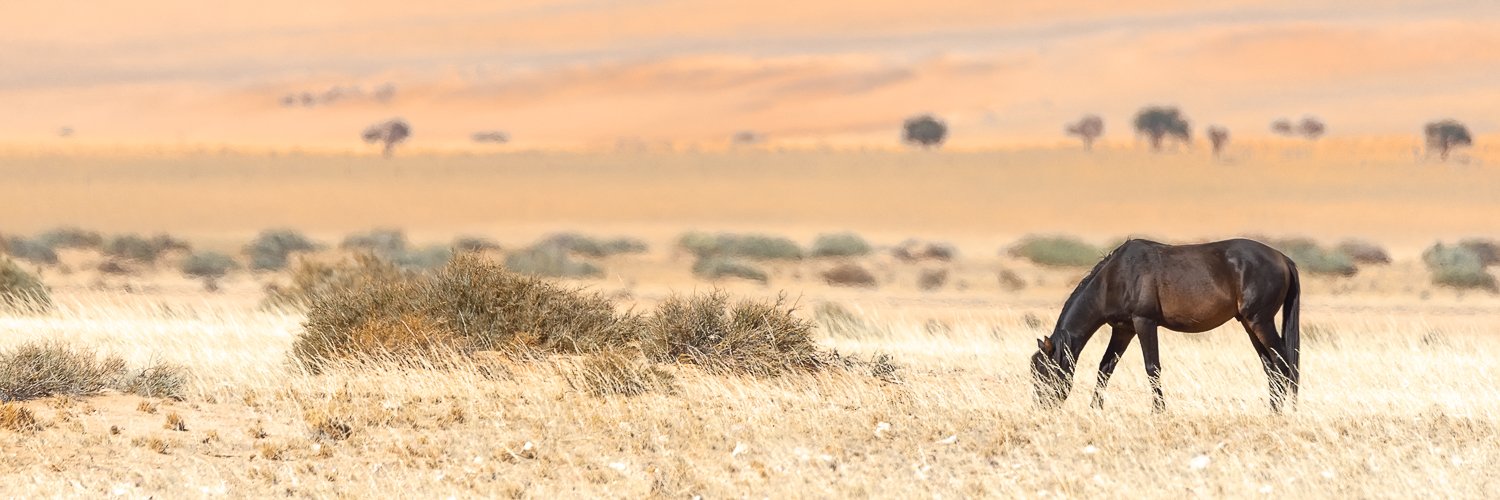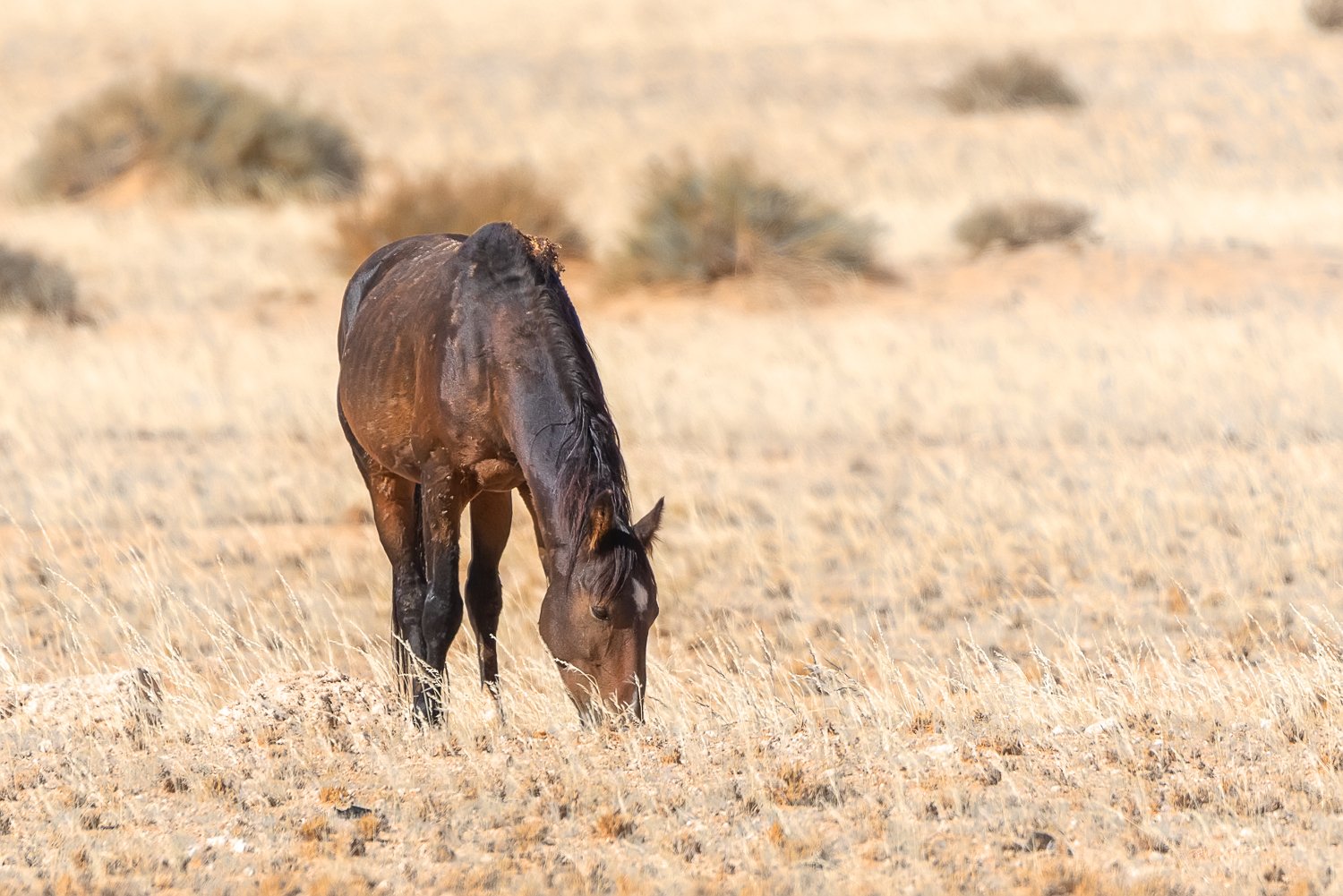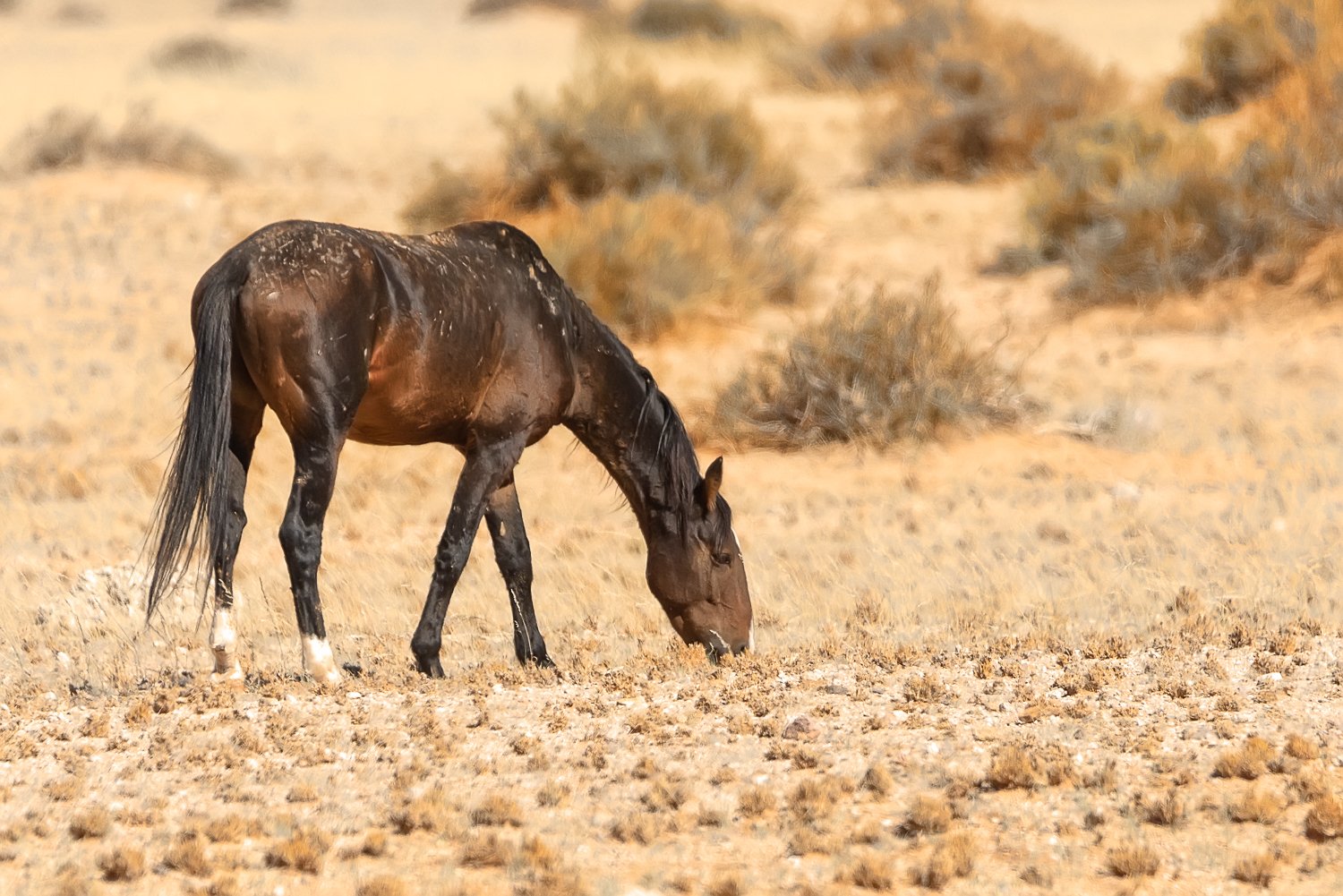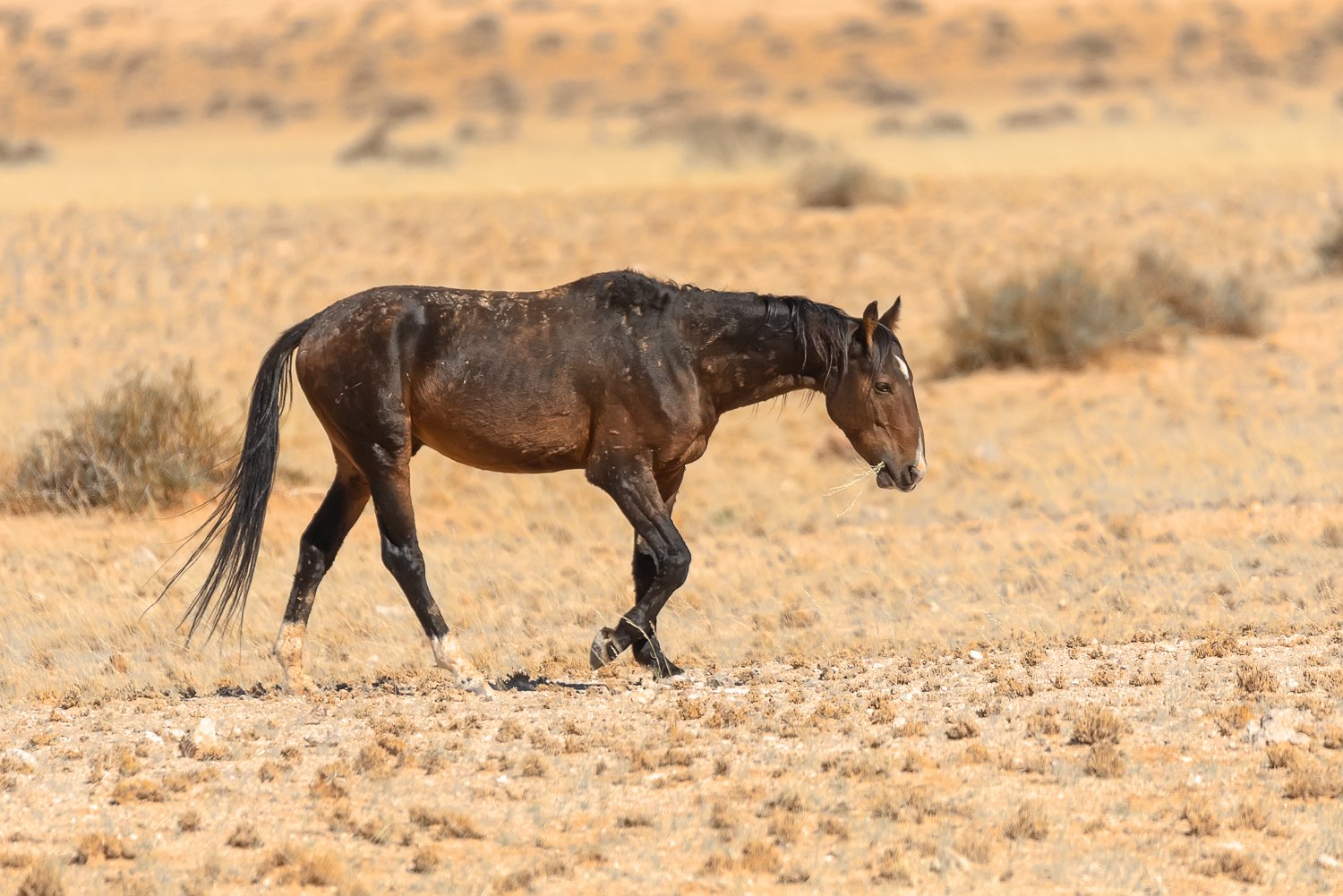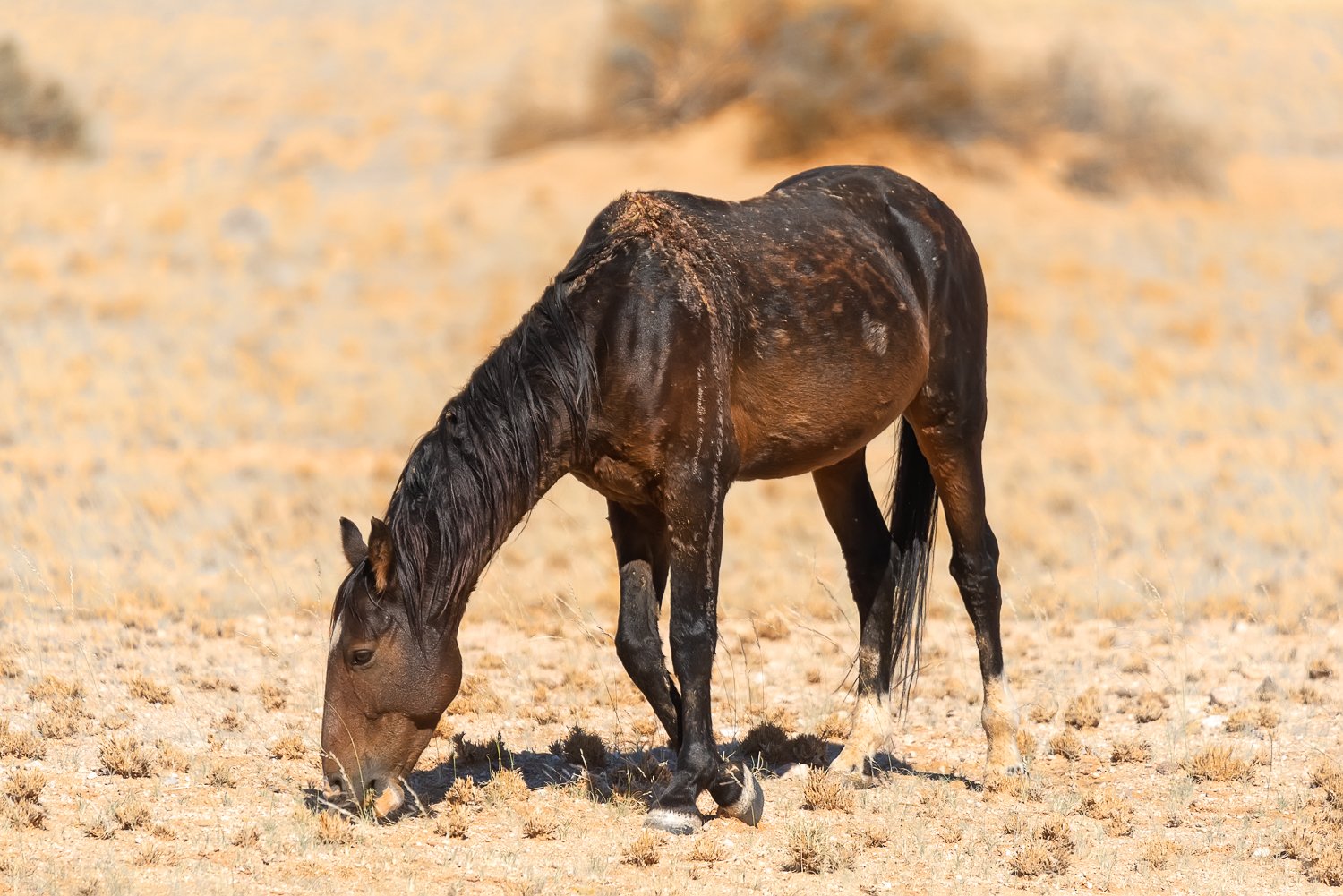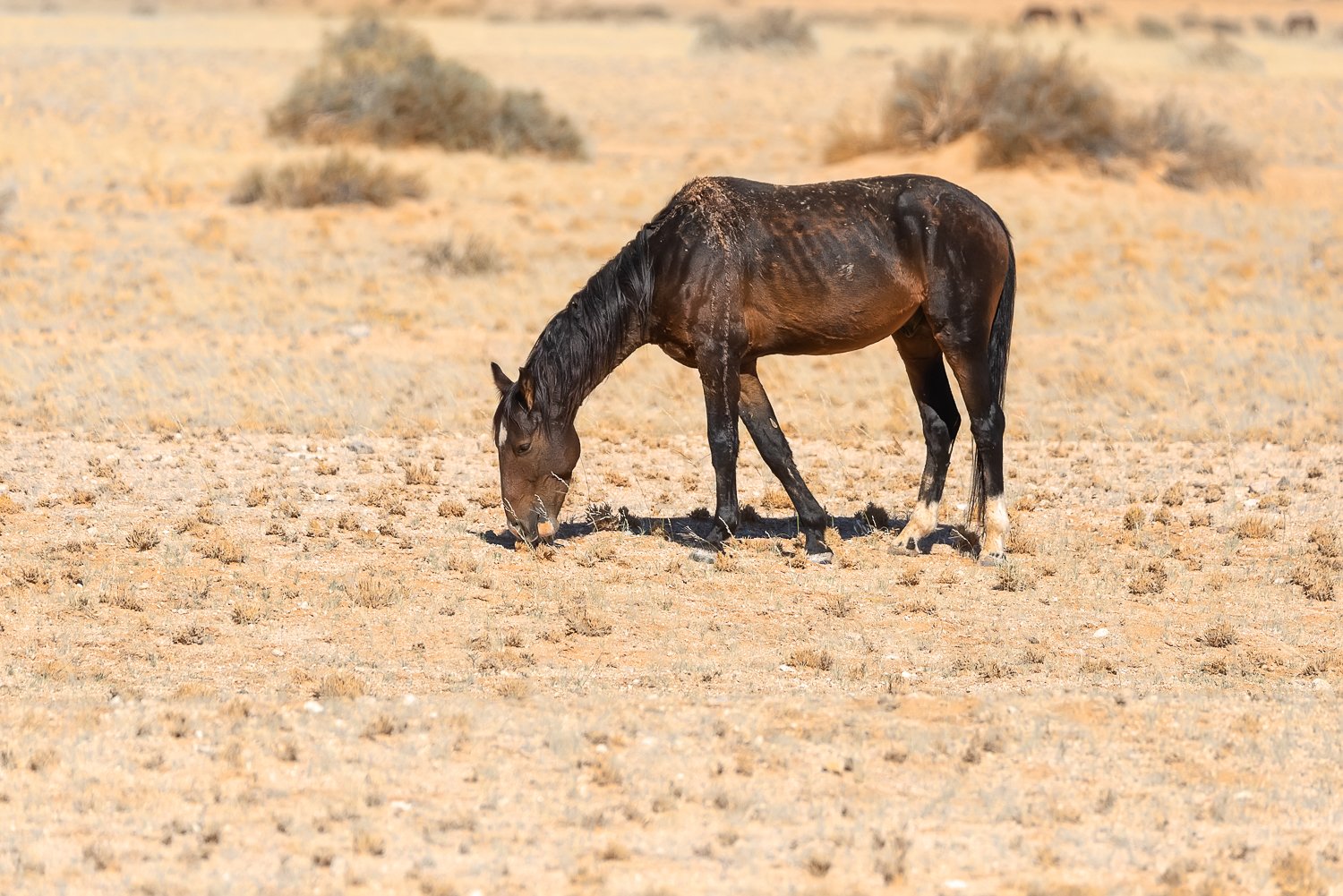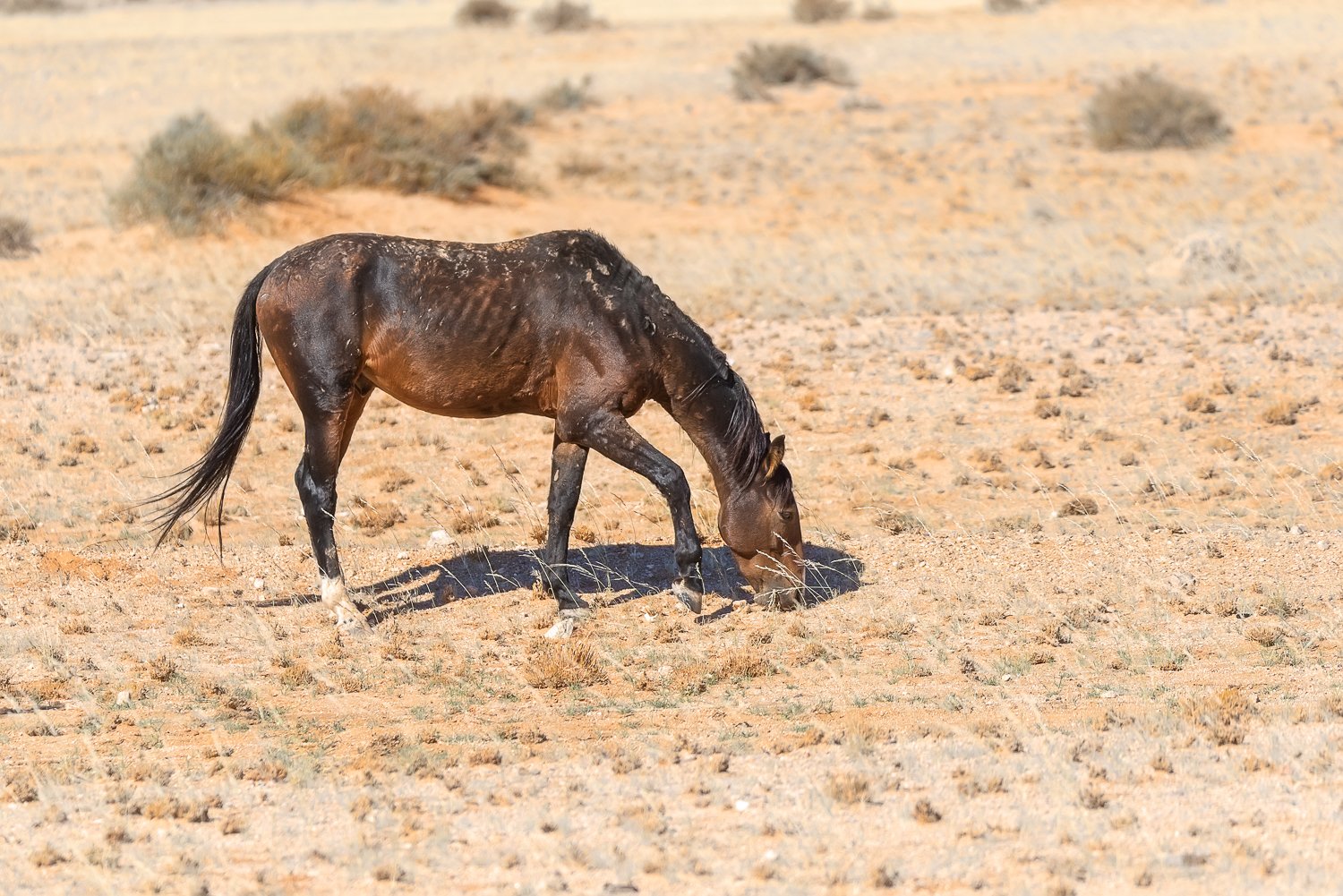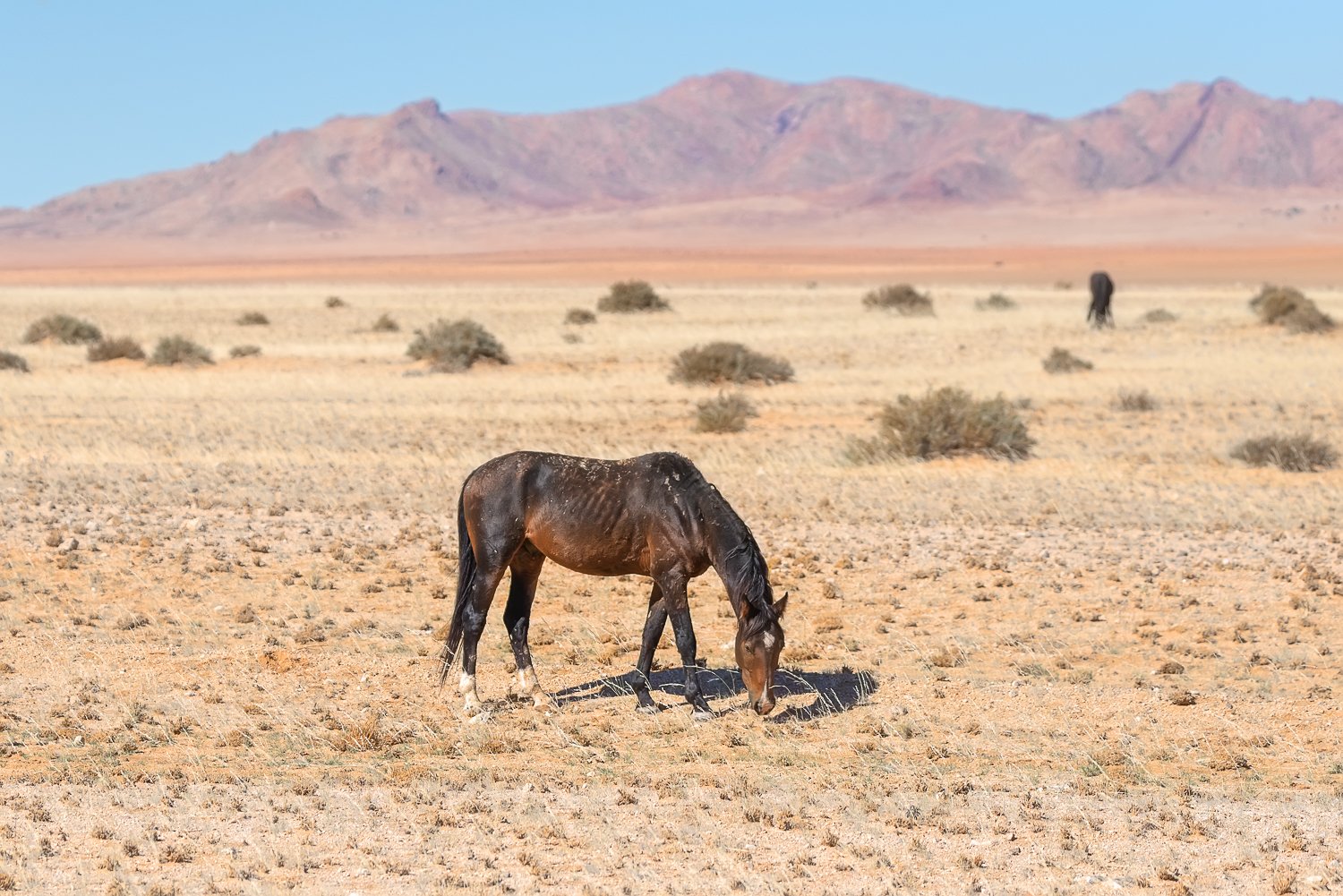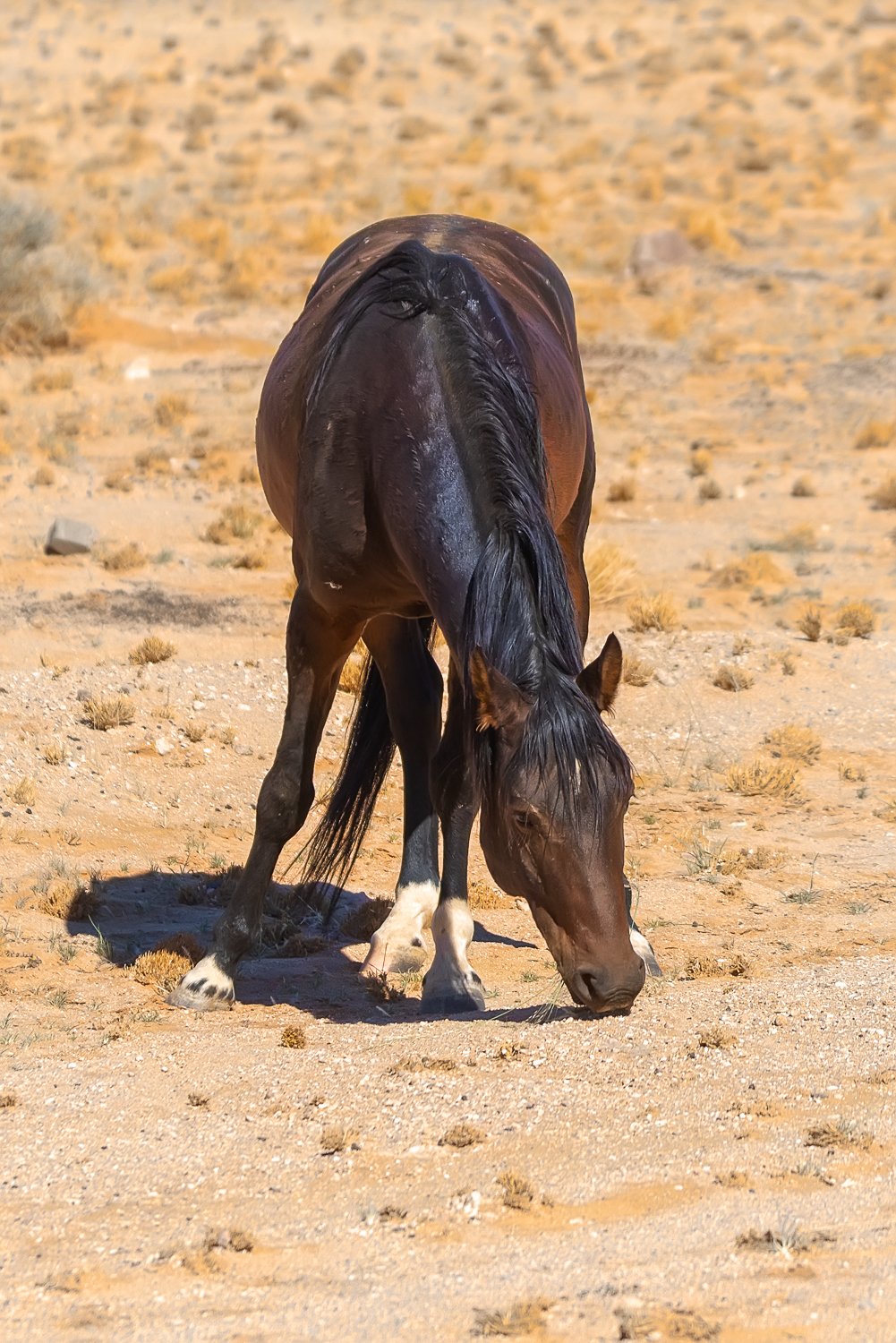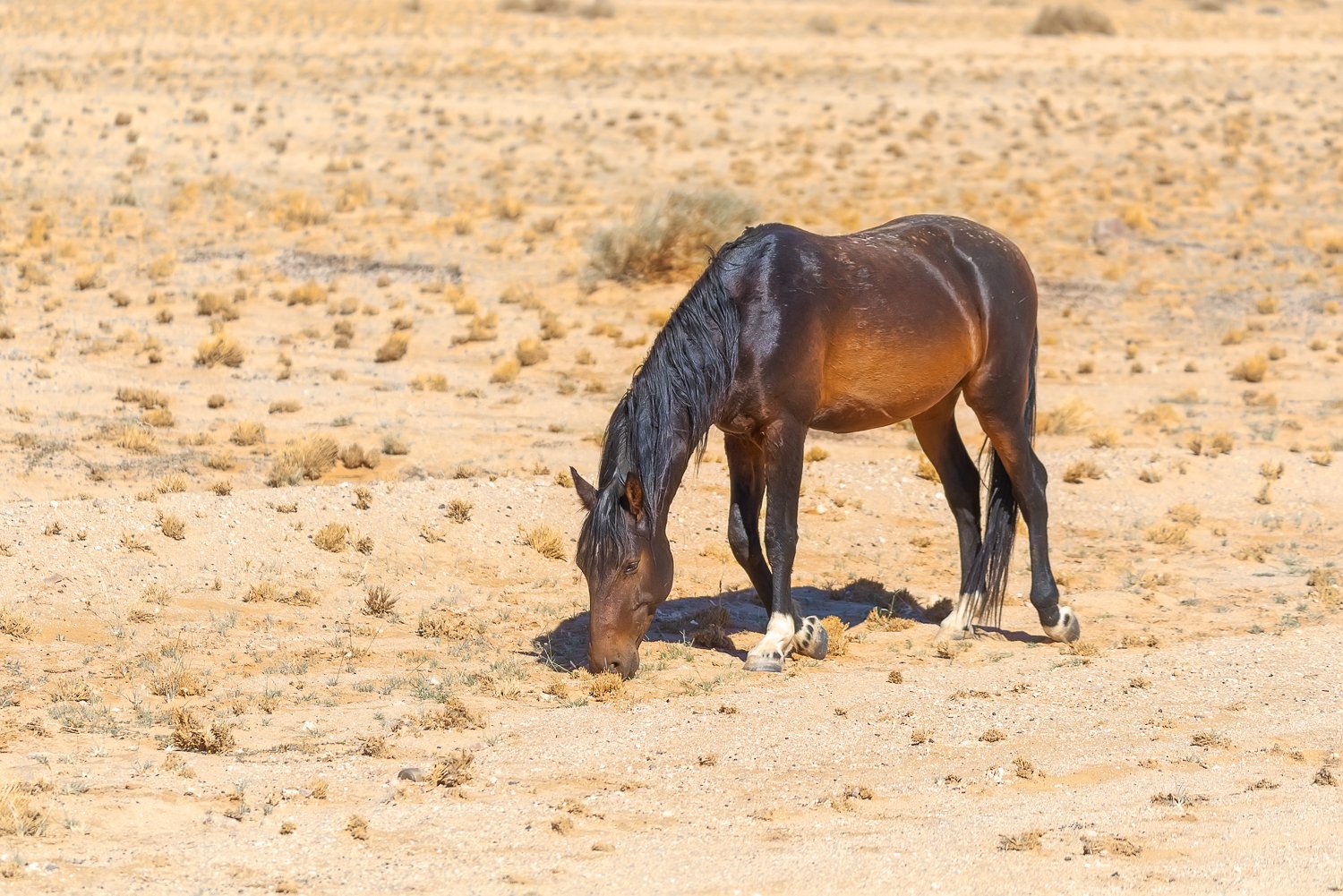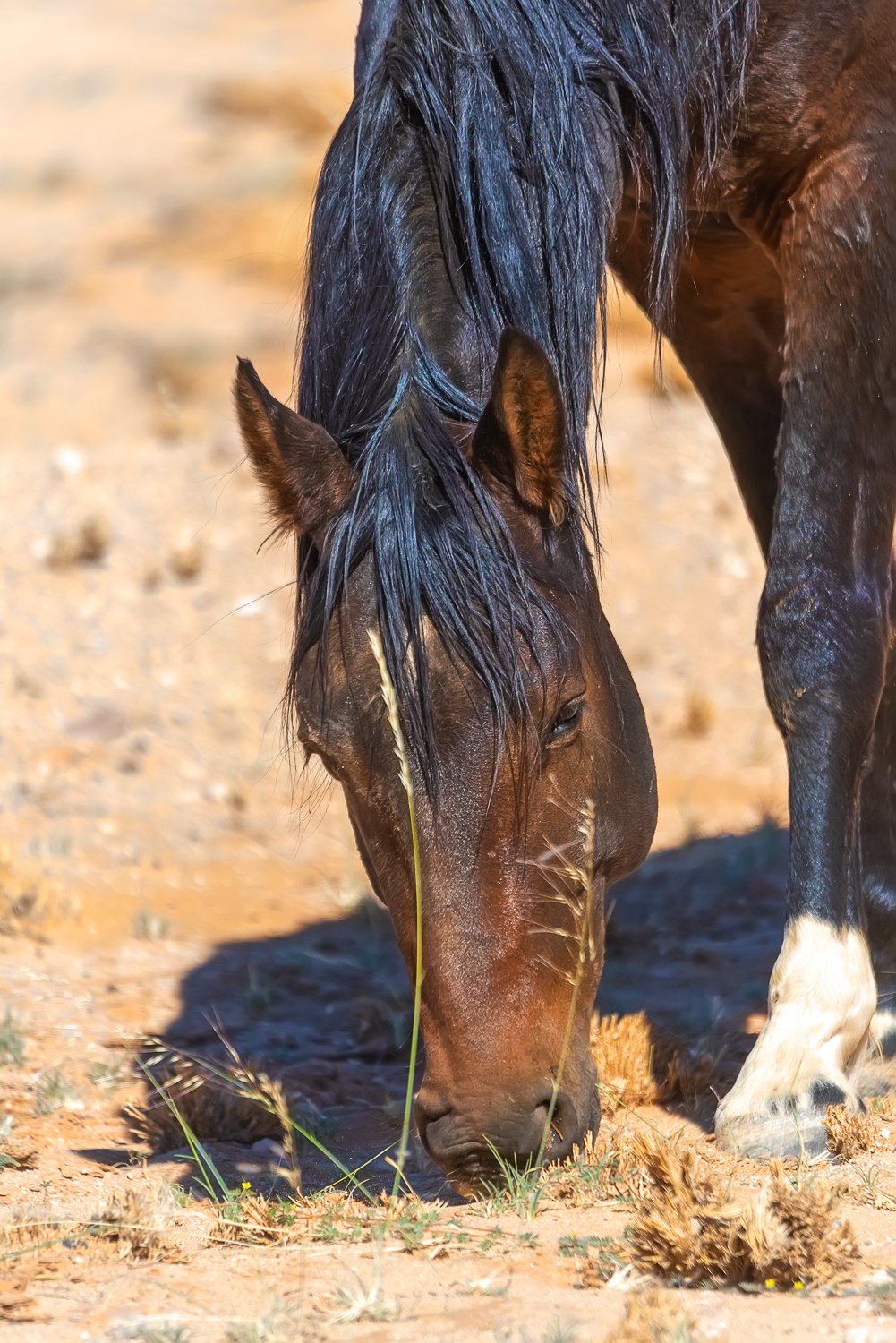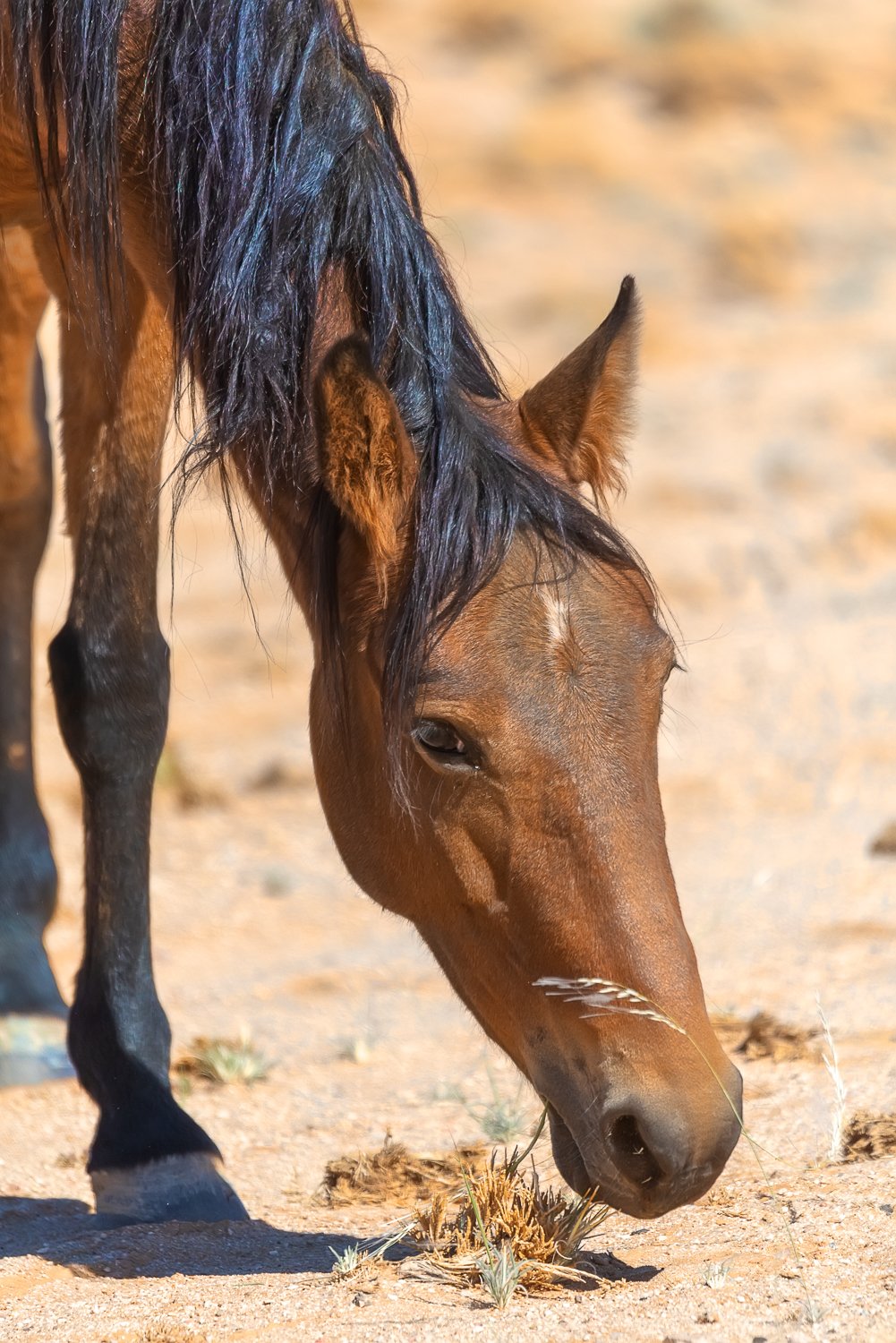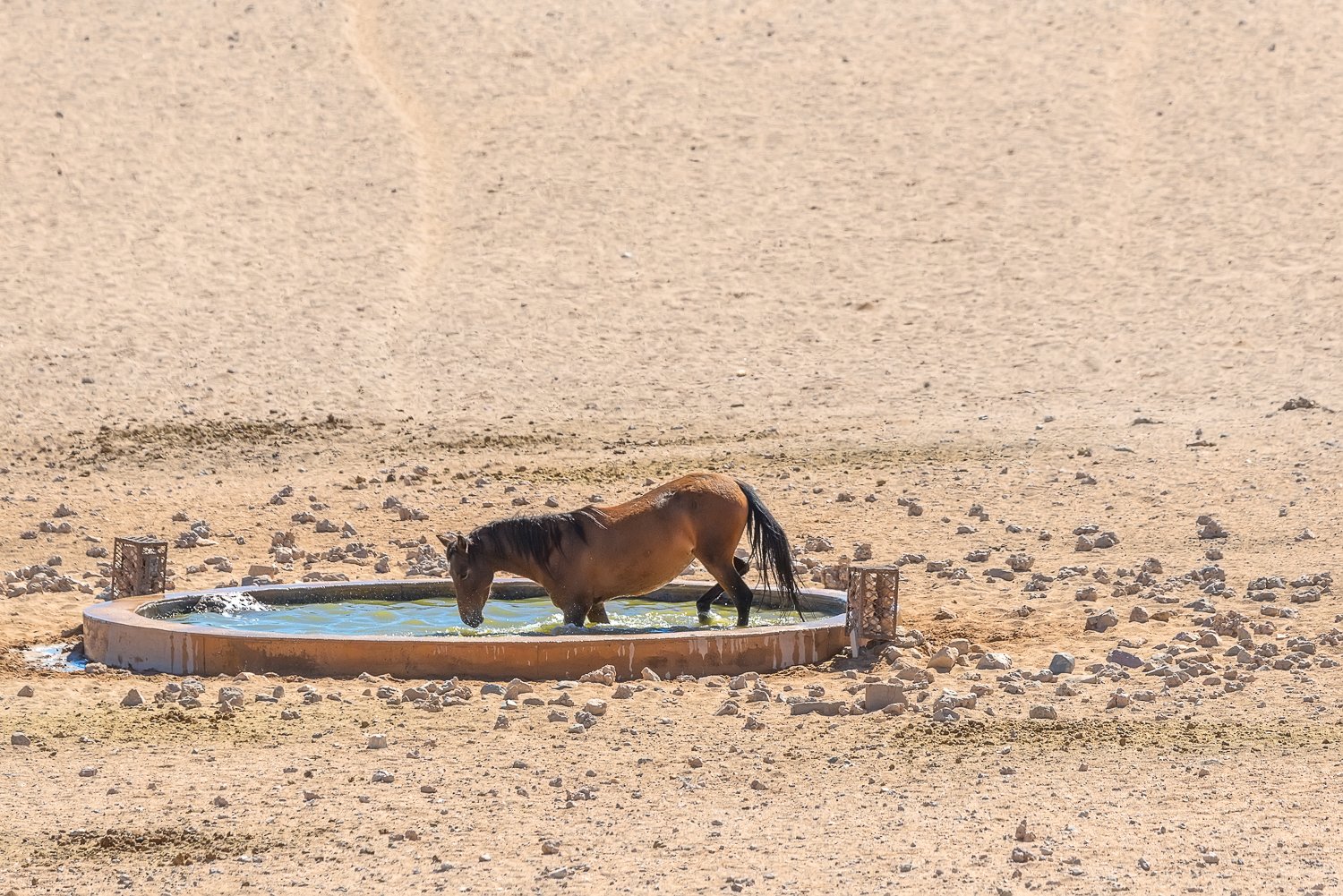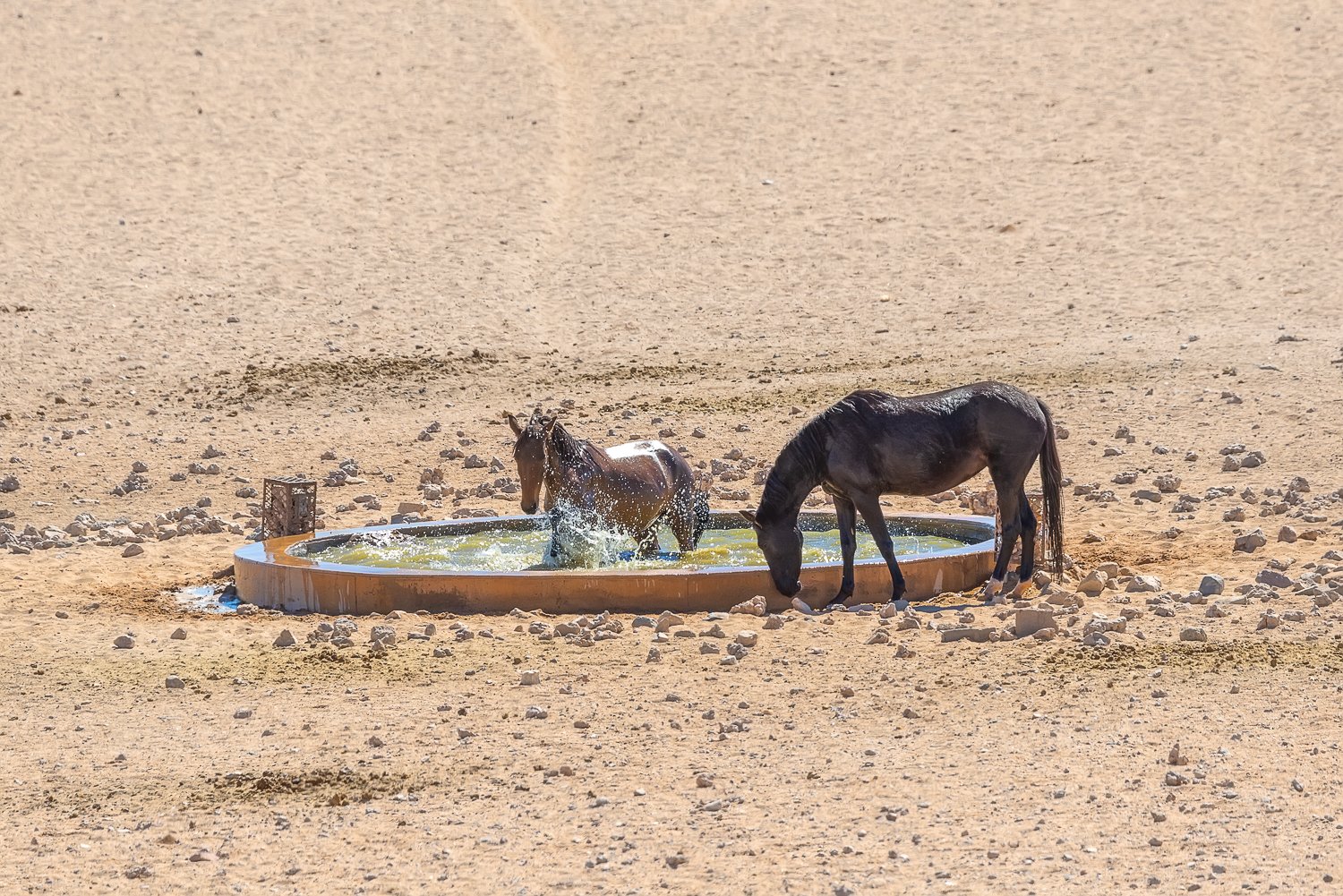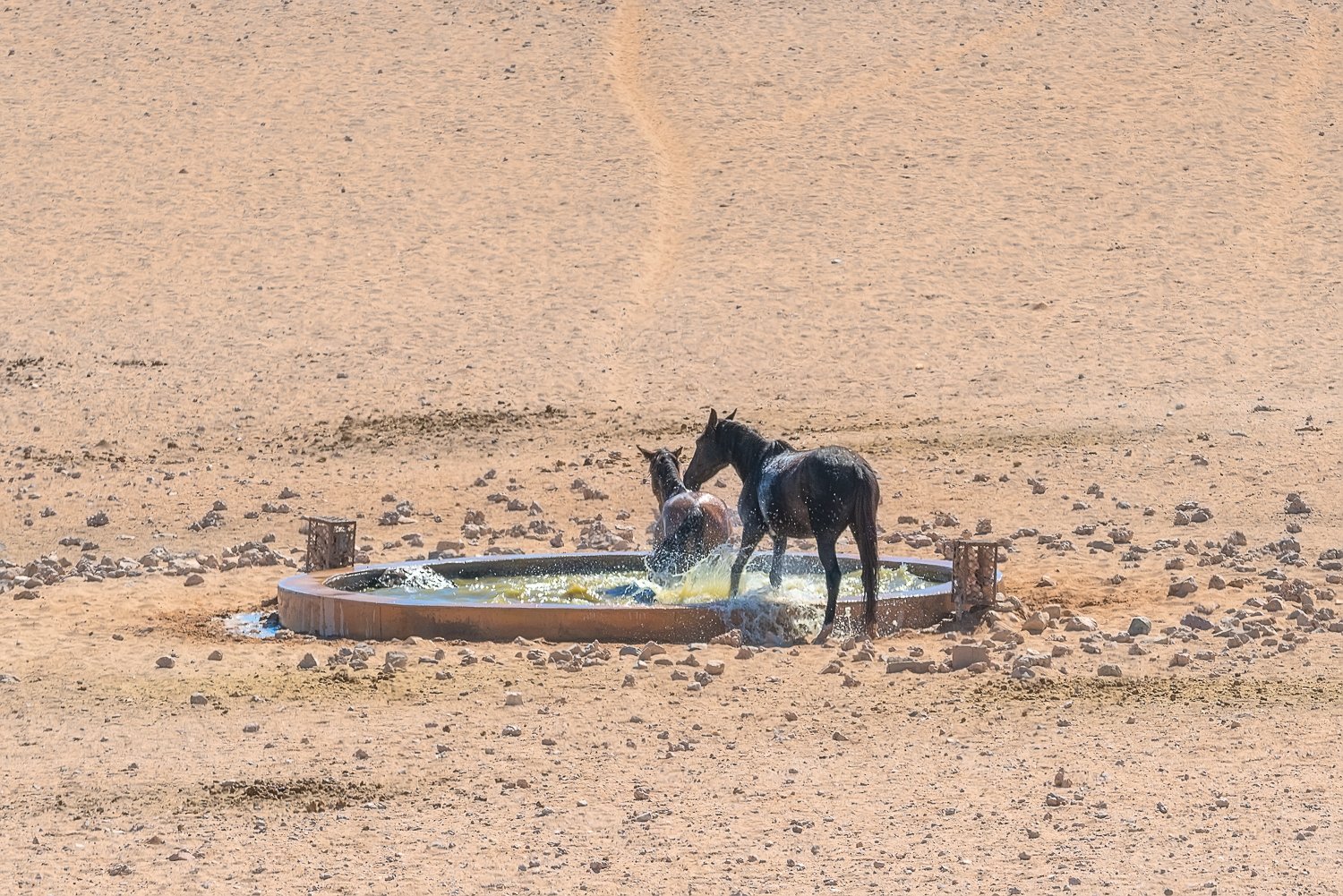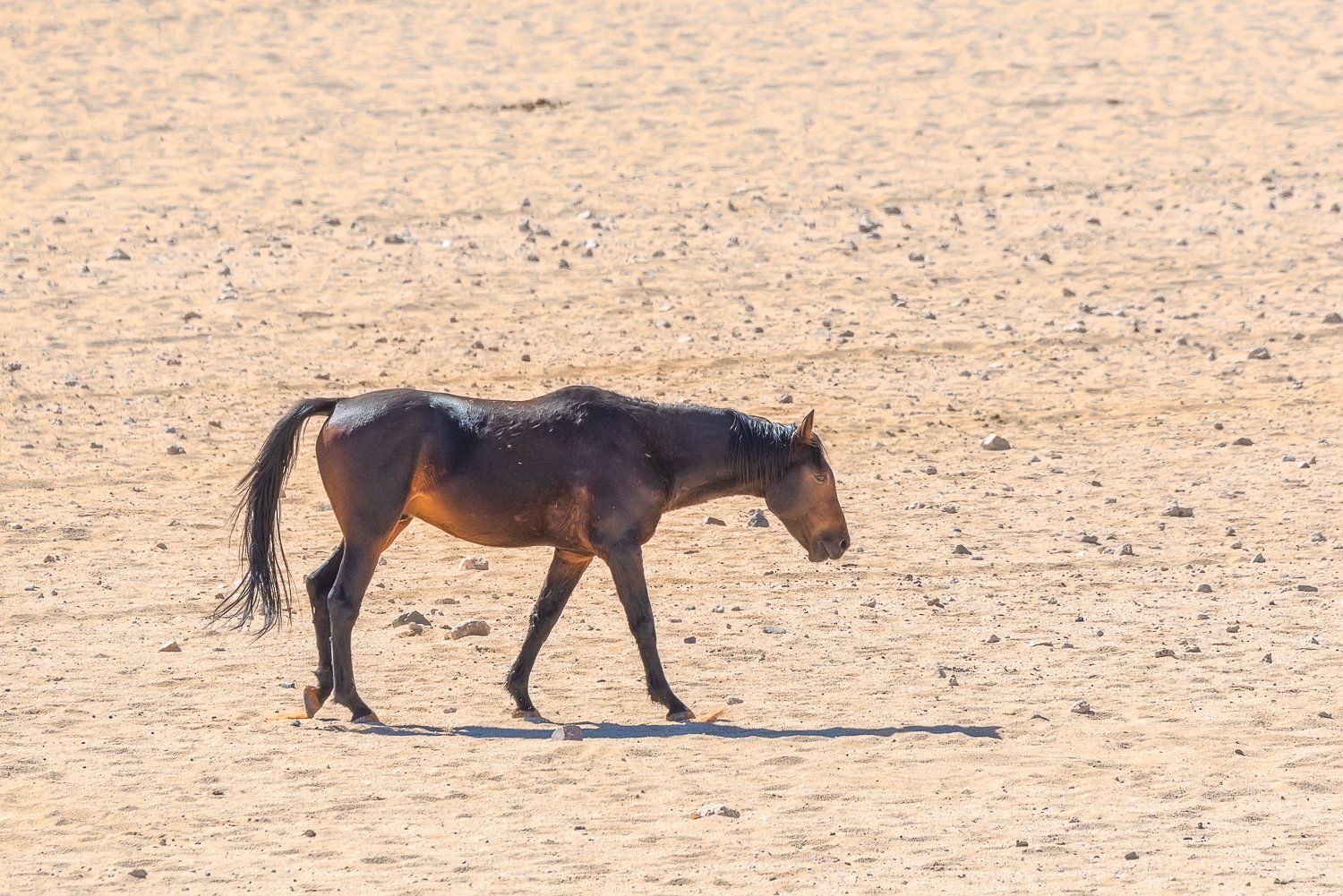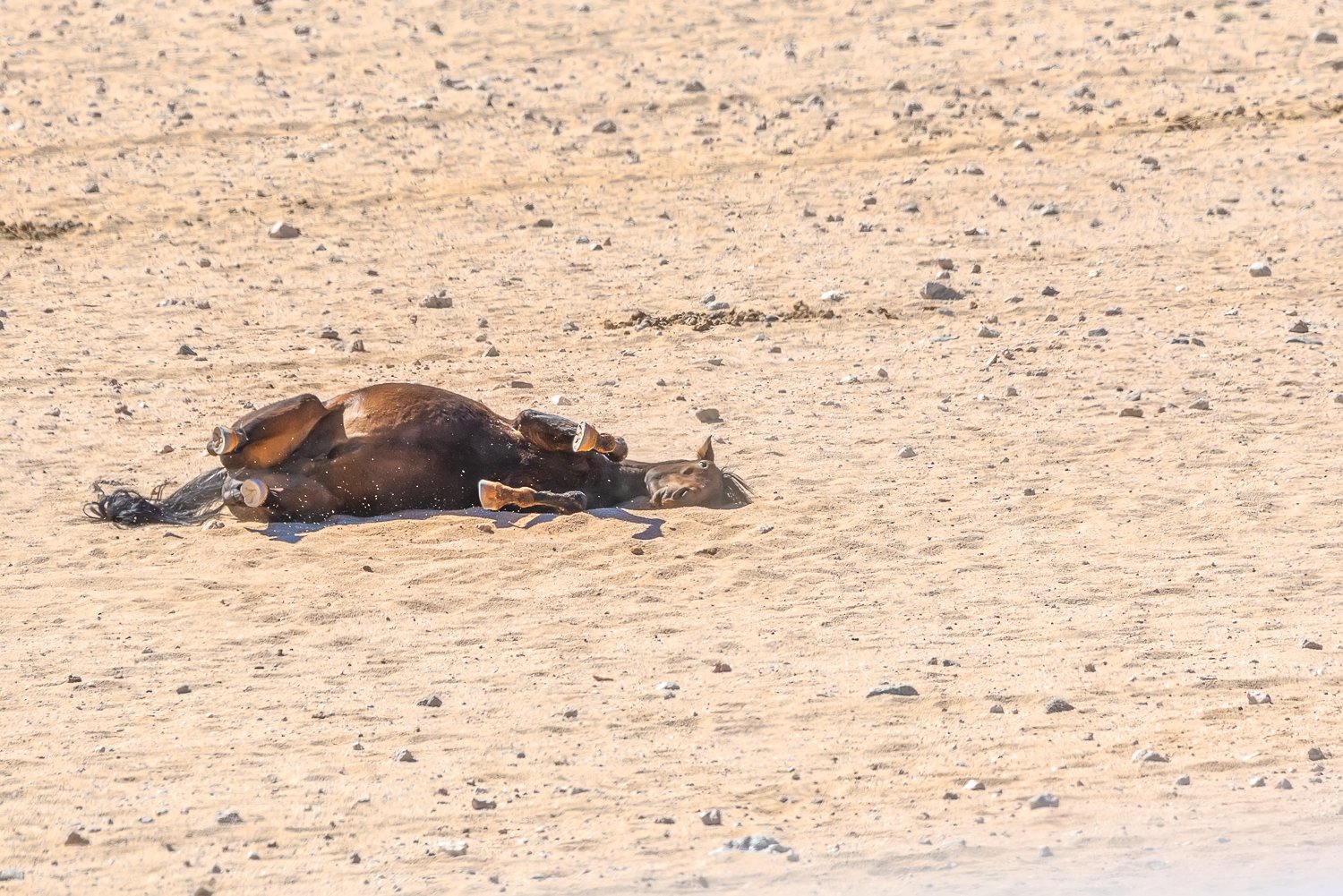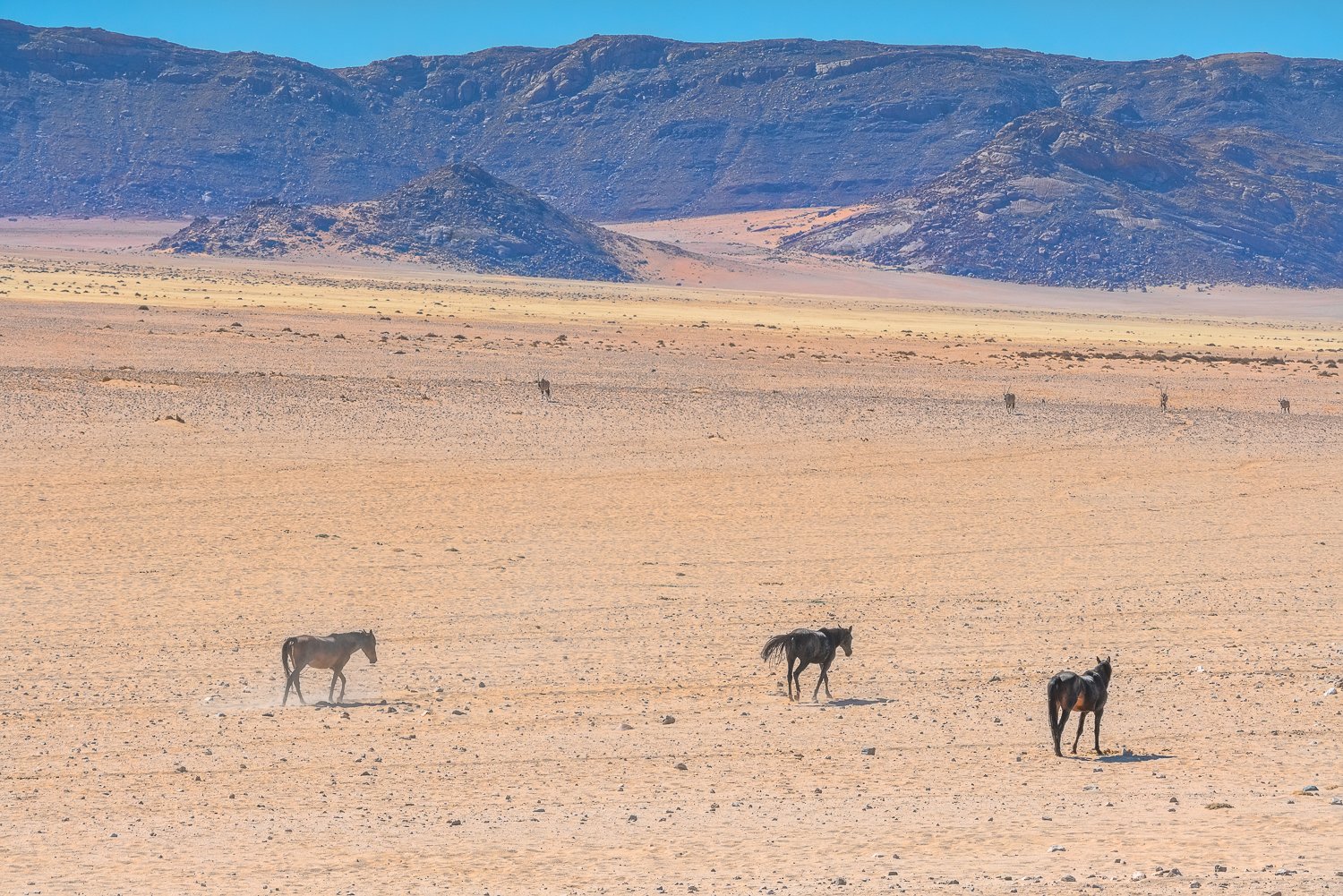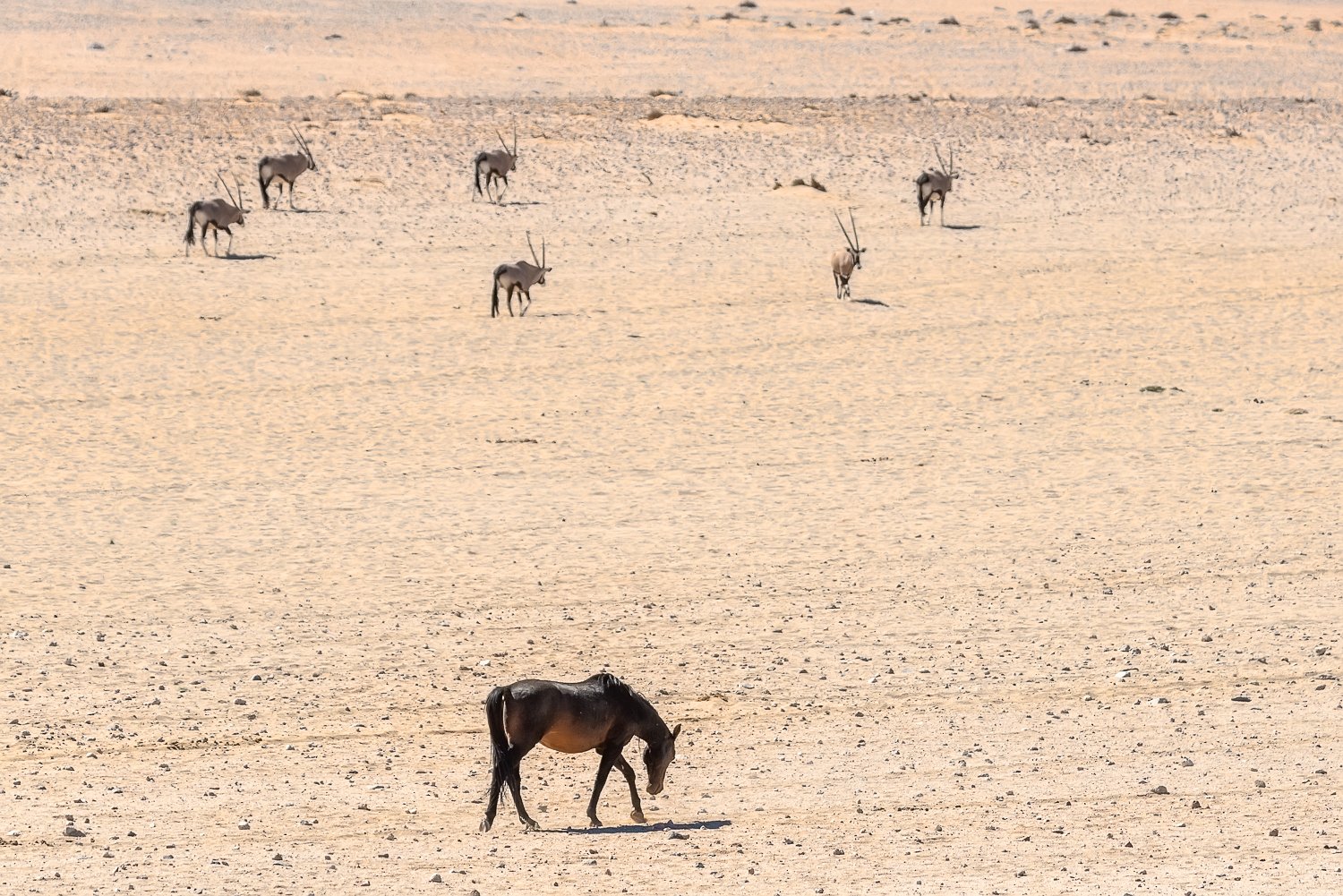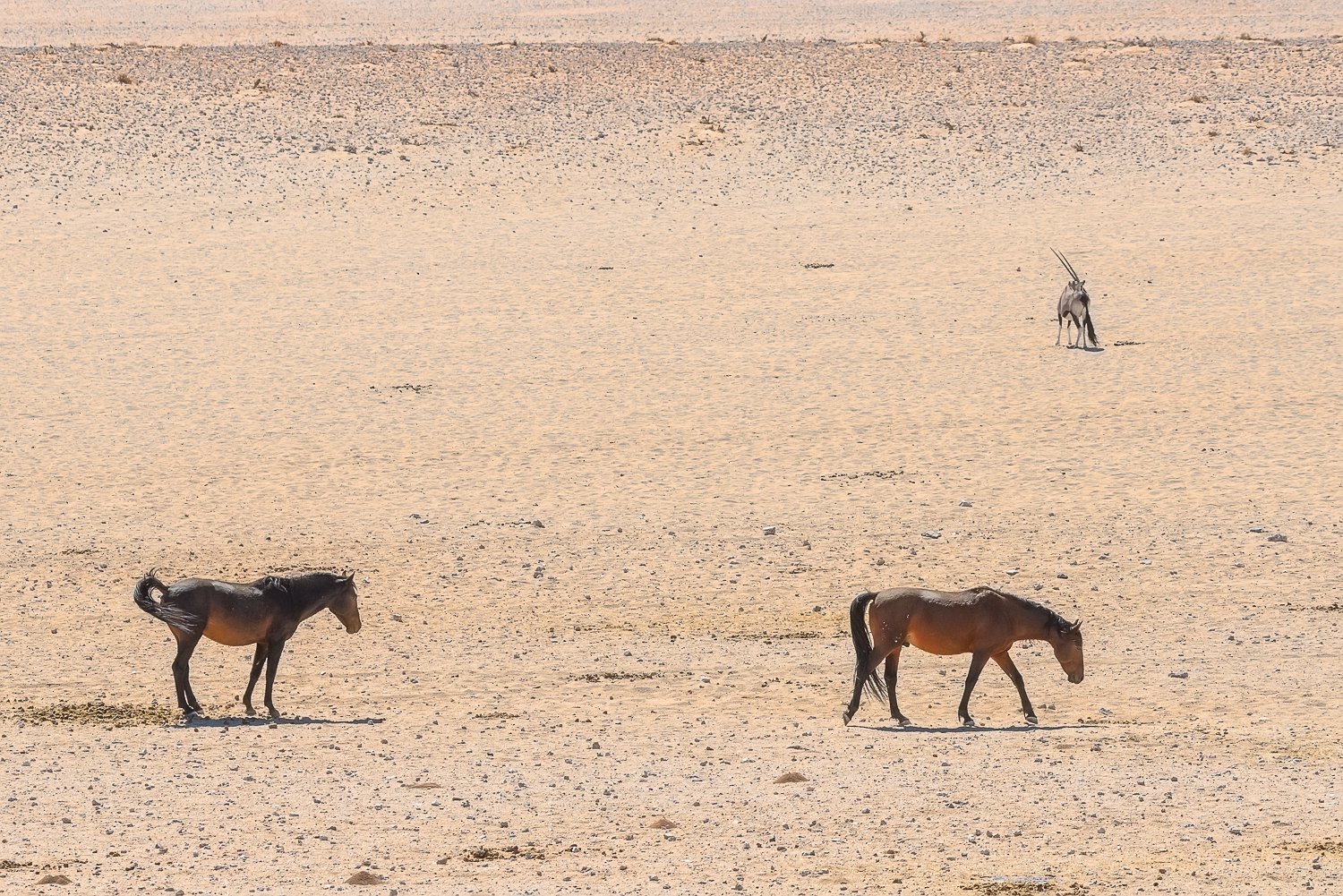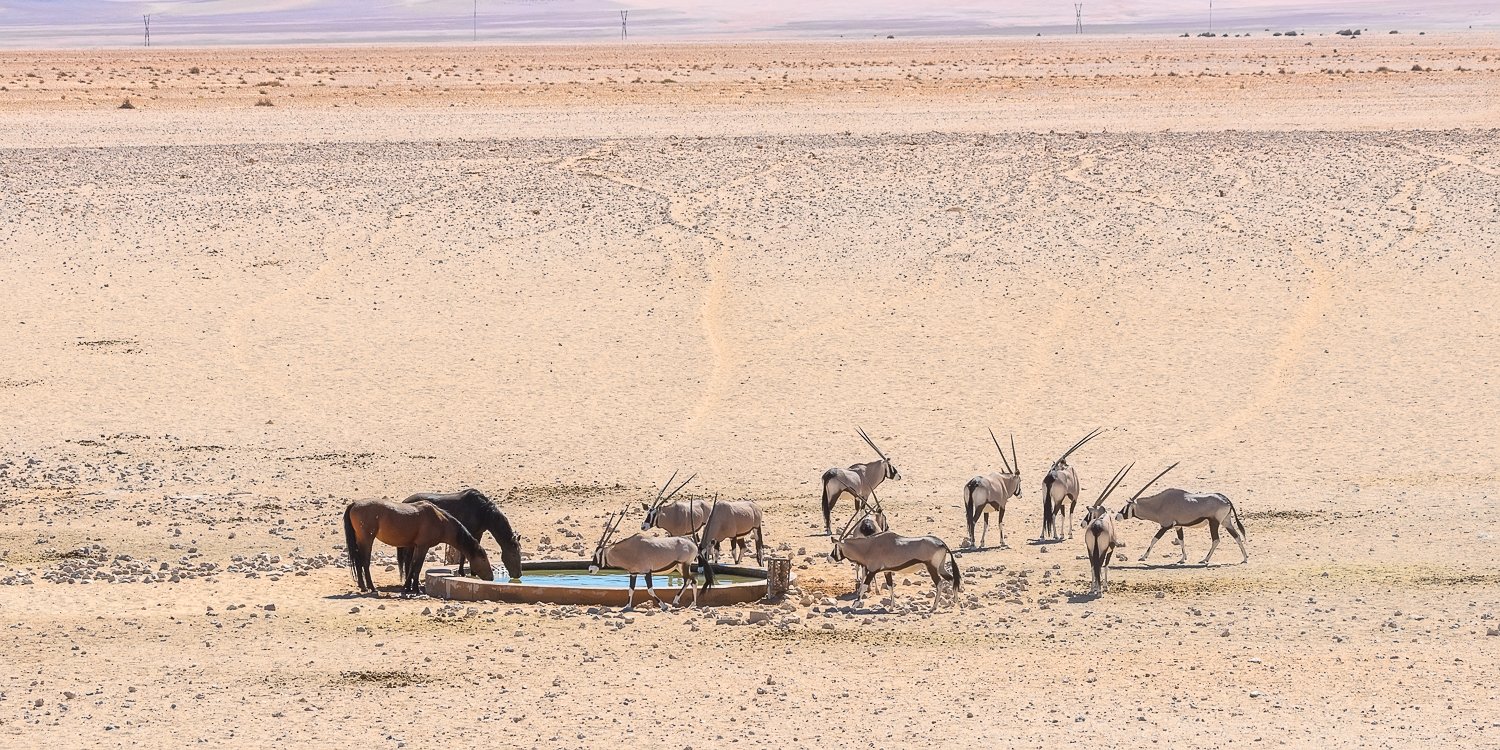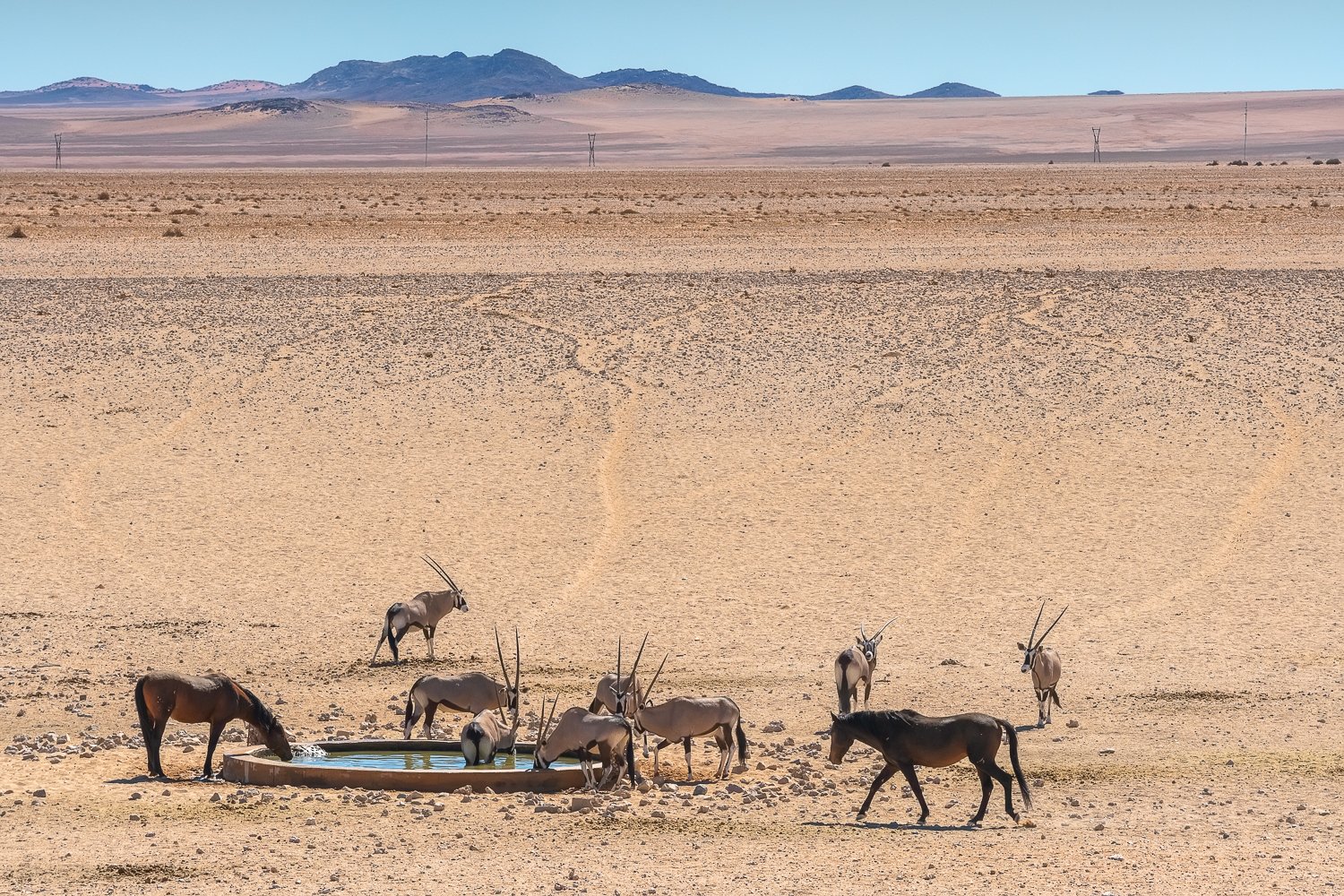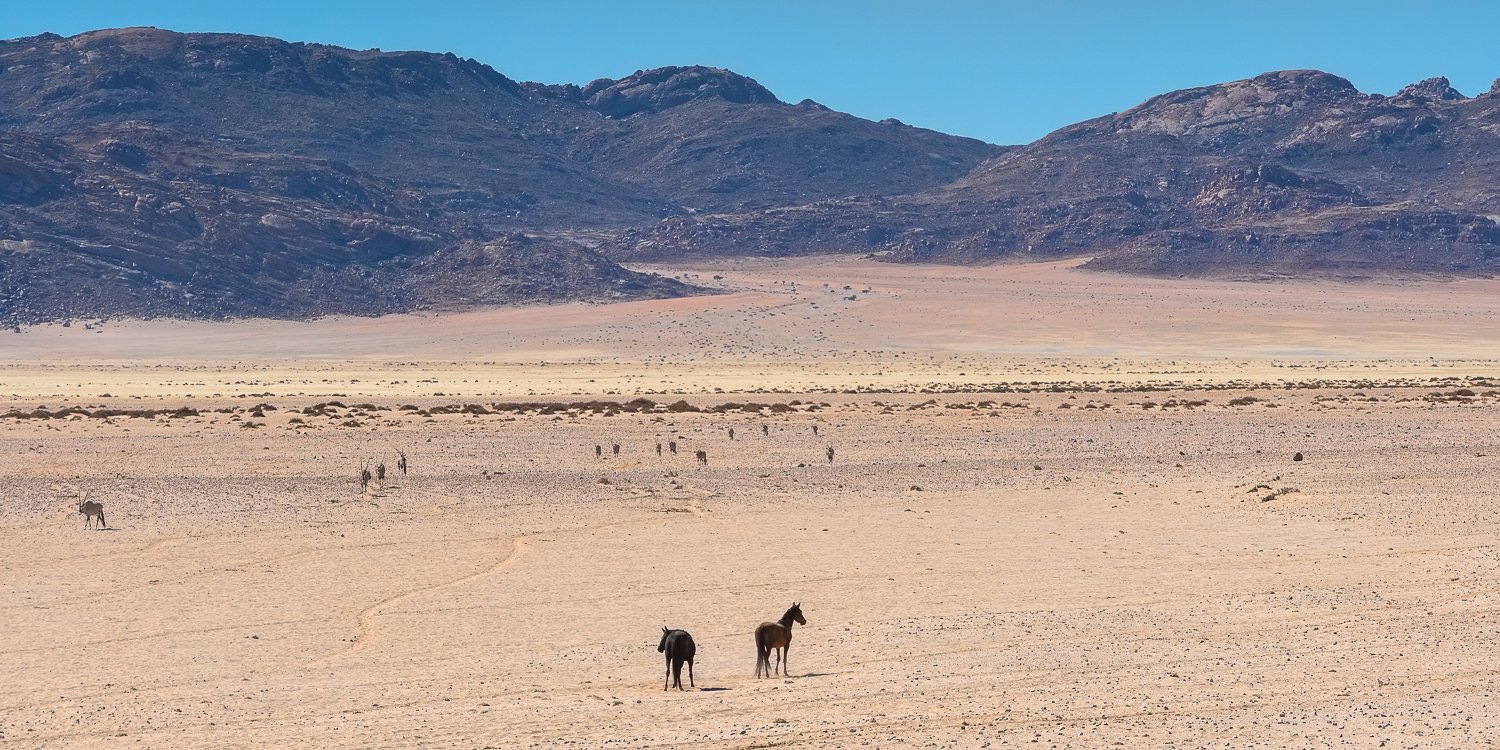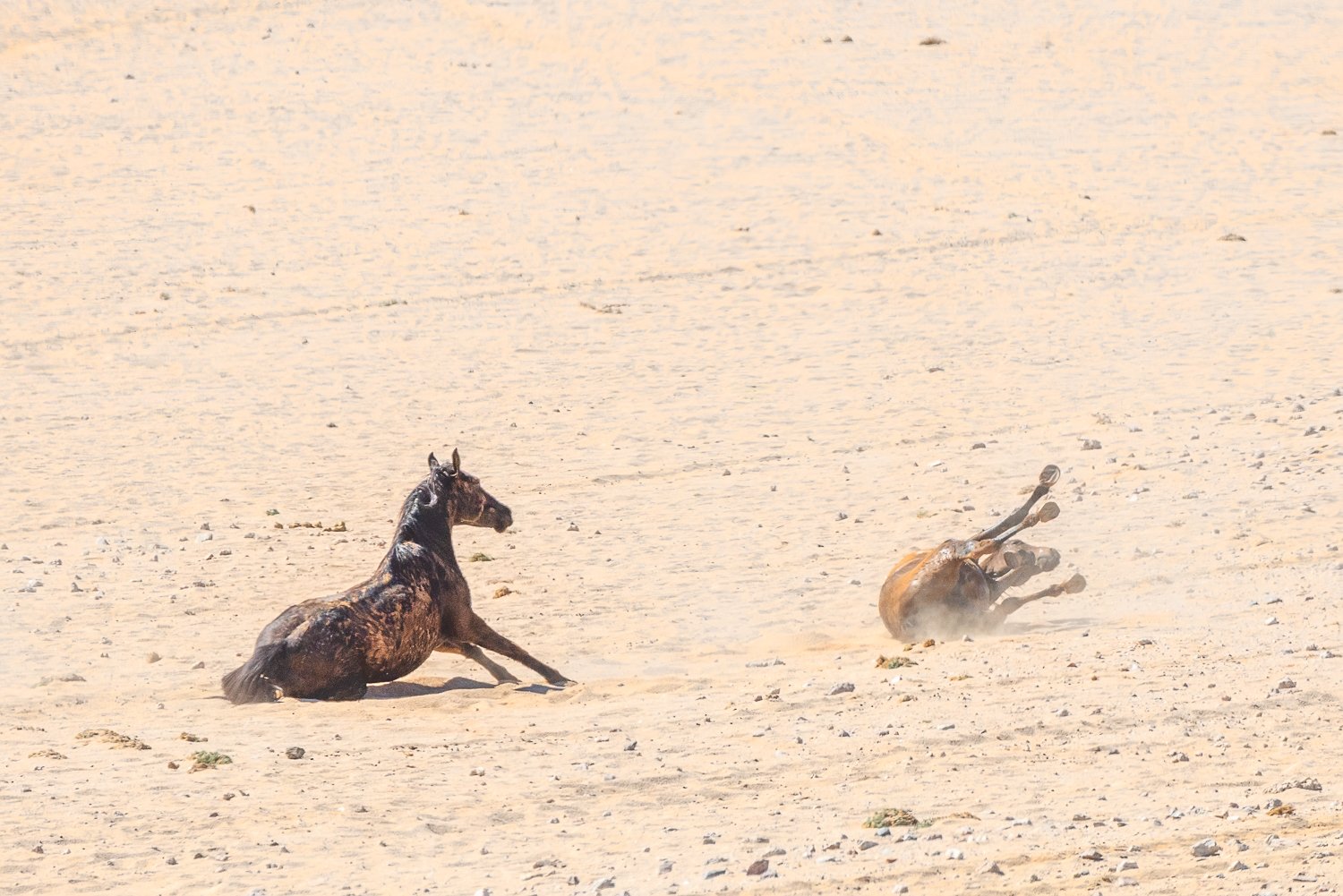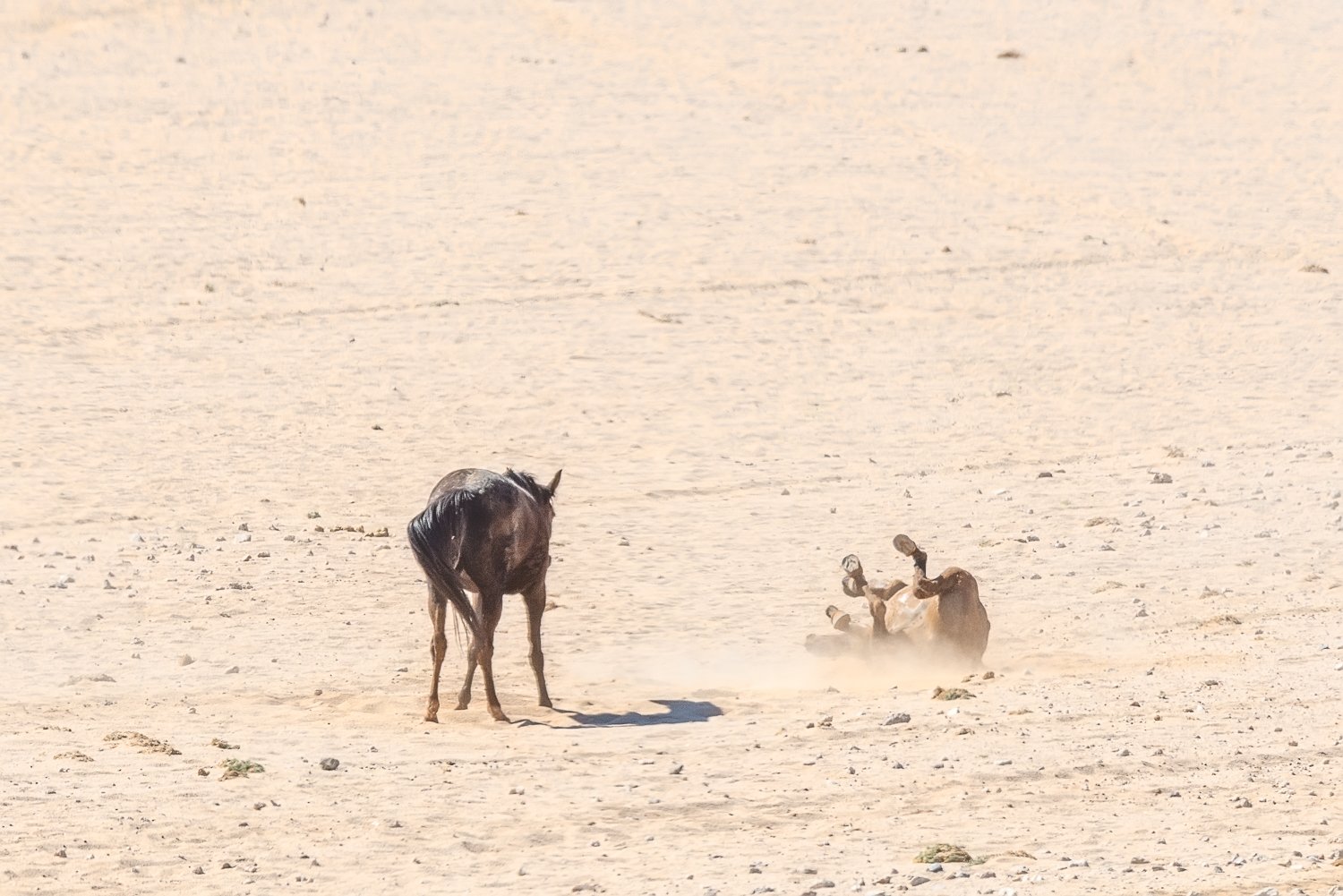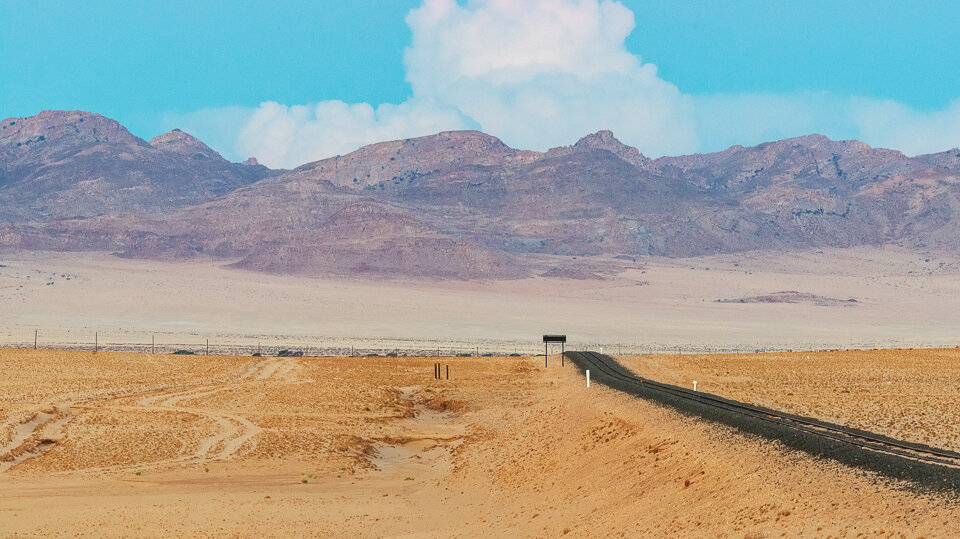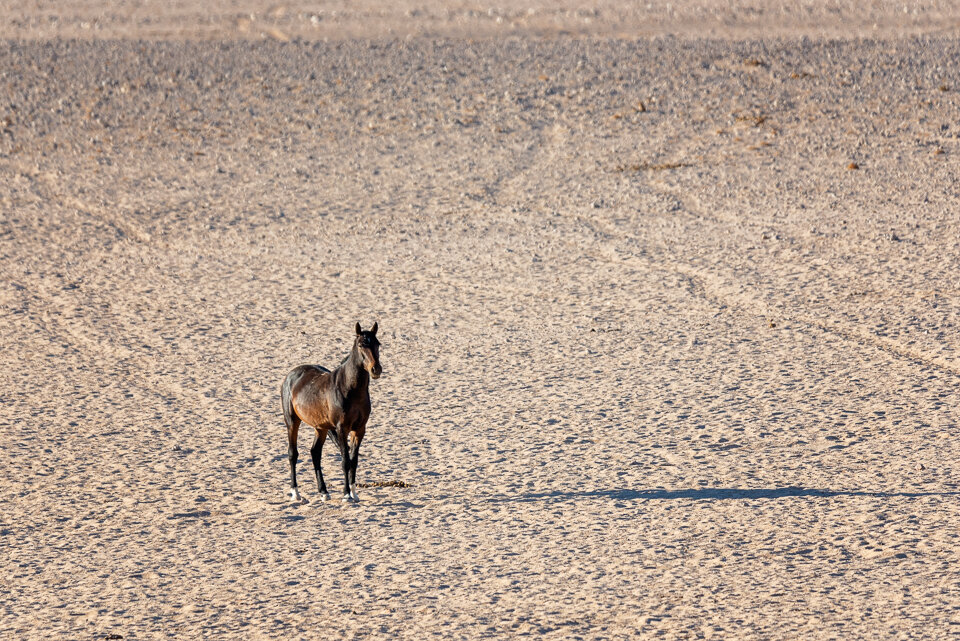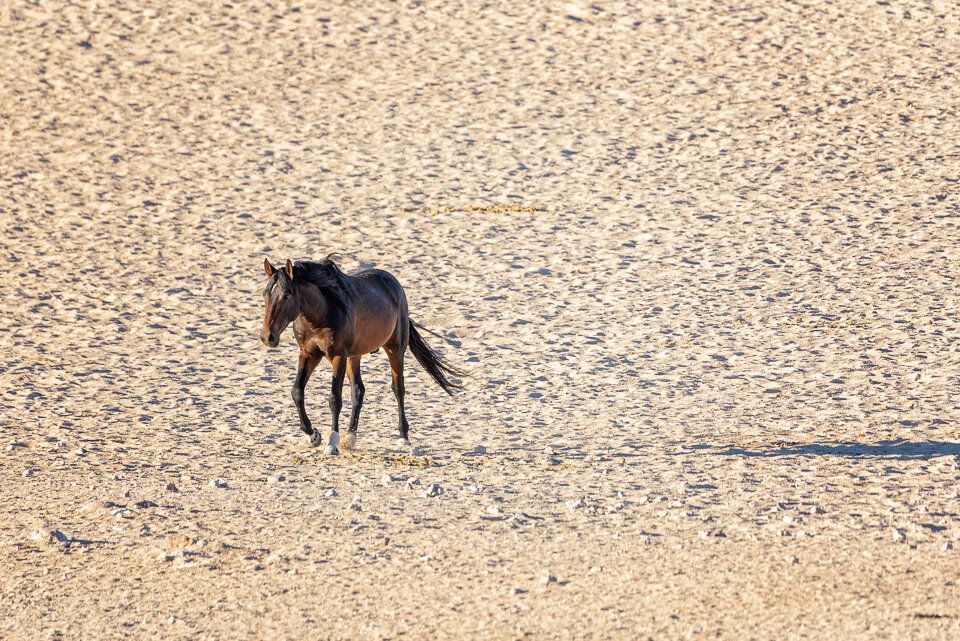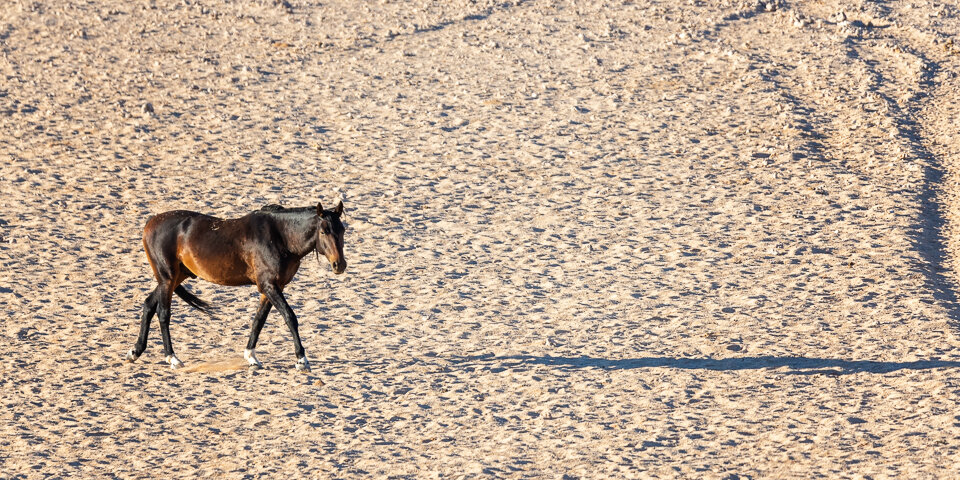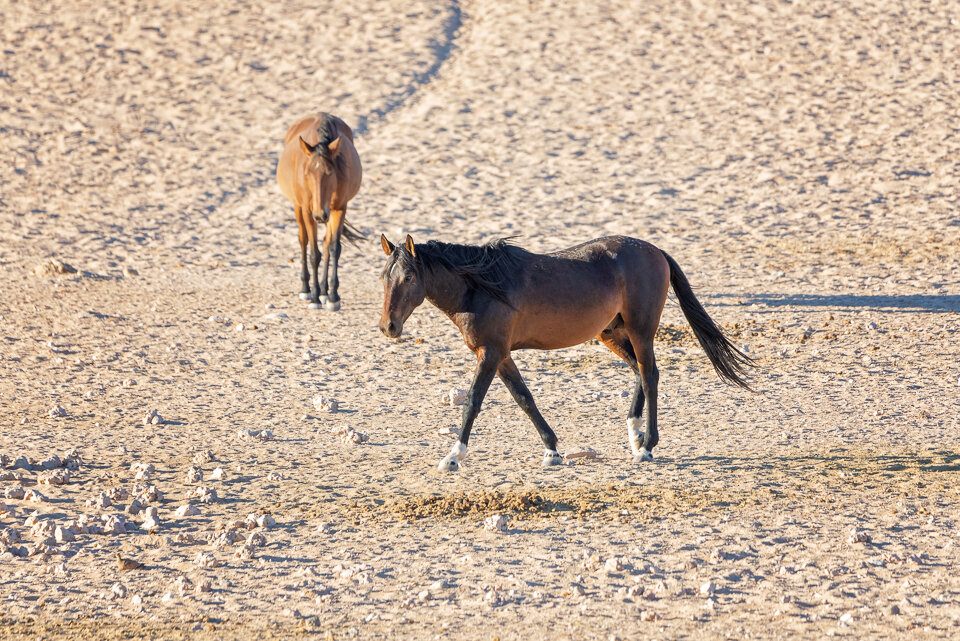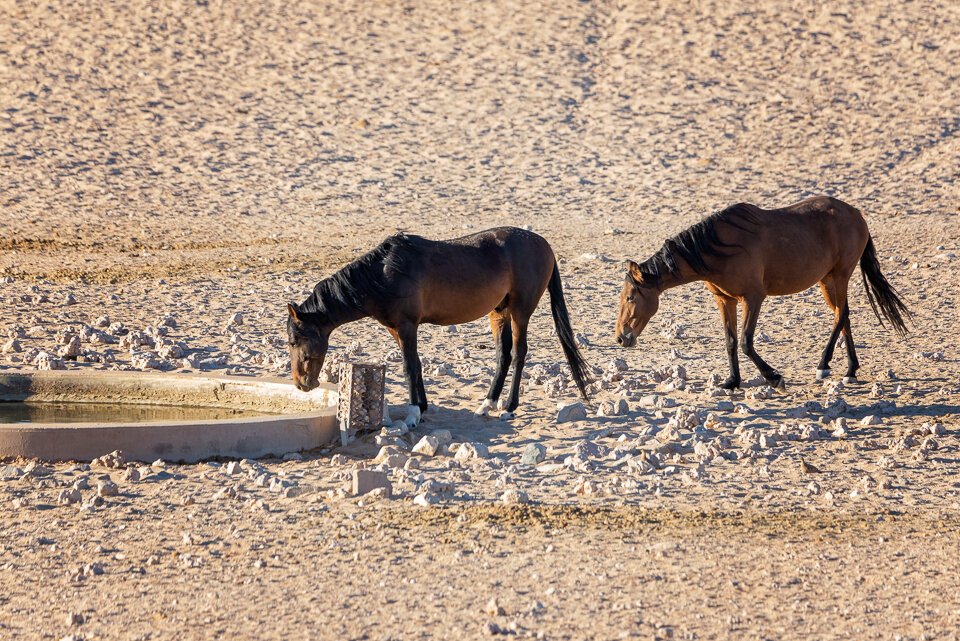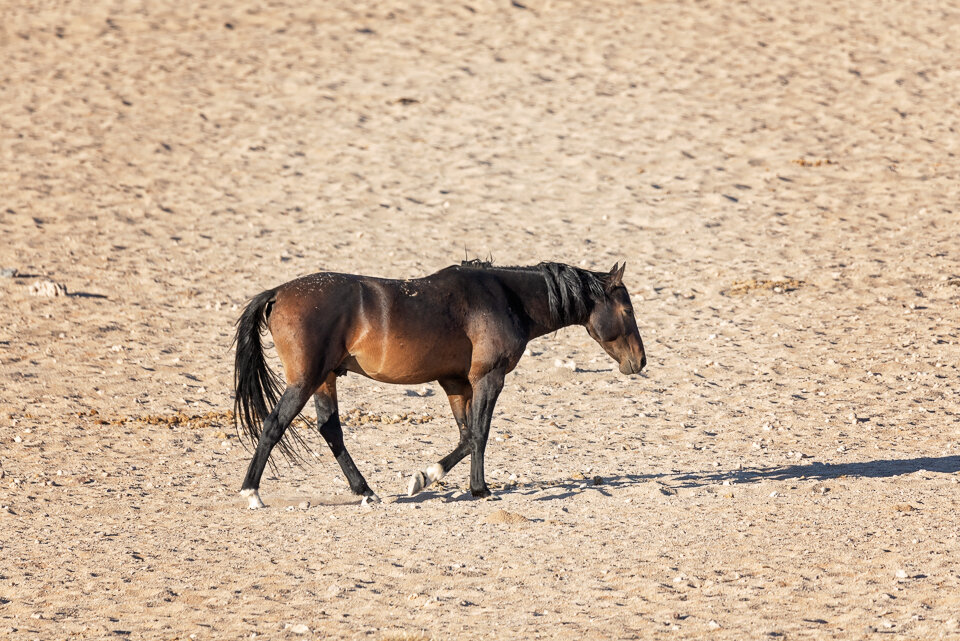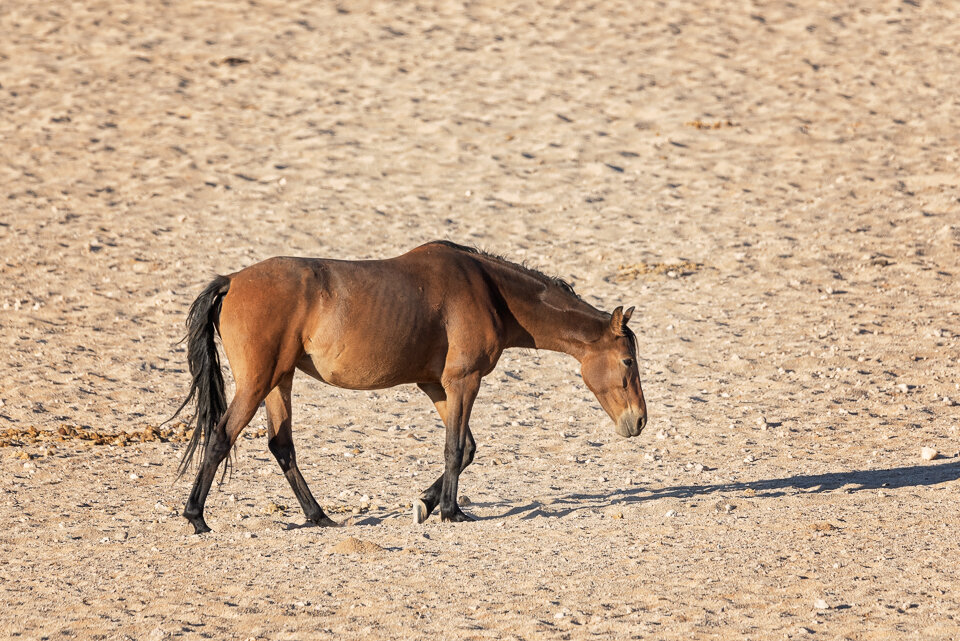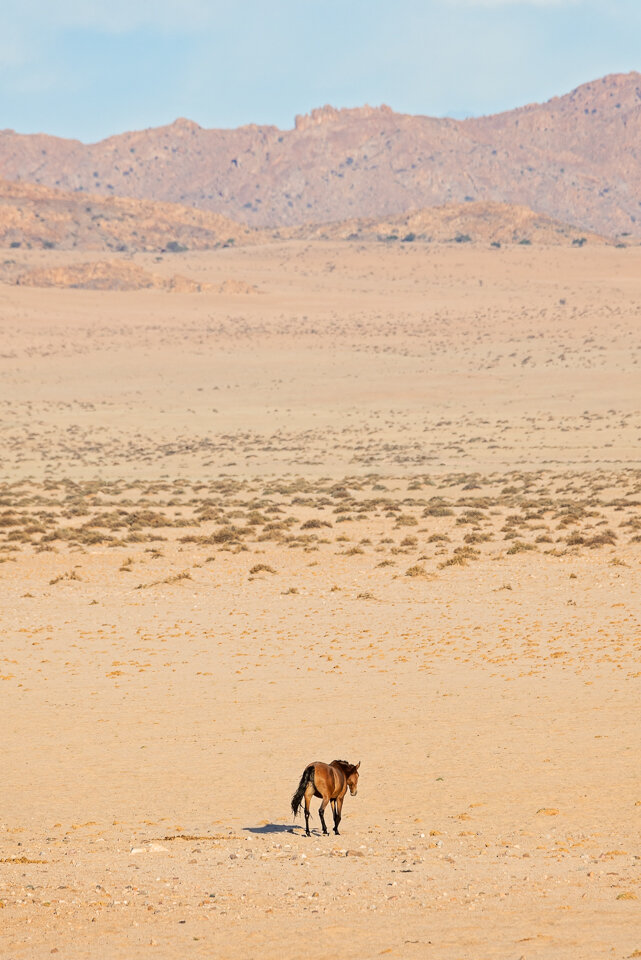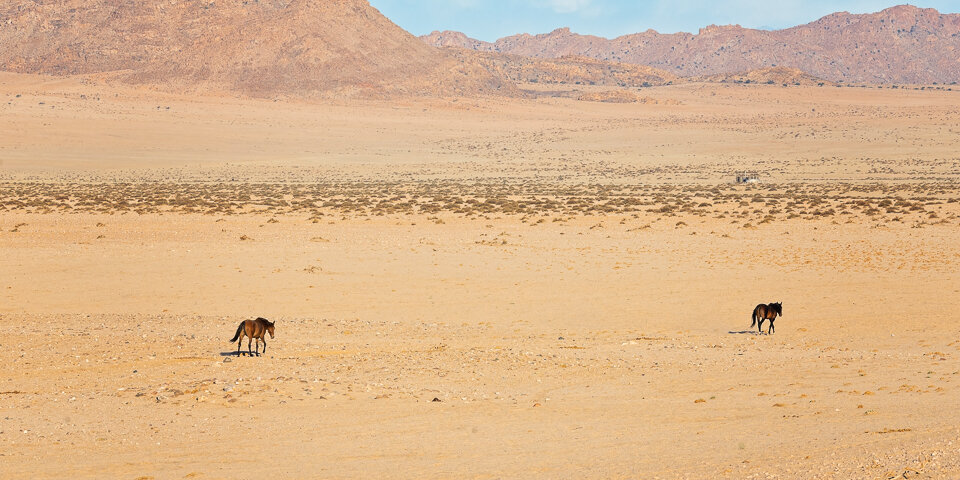And thus, we are on the way to the water hole, hoping to see the deserted horses again. And then I scream, “stop the car, stop the car”. There they are, blissfully unafraid of us and focused on feeding. I have minimal experience with horses, so I hope the state of their mane does not mean they are ill. Later on, we see a few of them at the water hole too. They drink water, they bathe in the sand, and they play, and it makes my day.
I tak oto jesteśmy w drodze do wodopoju, mając nadzieję, że znów zobaczymy przystosowane do życia na pustyni namibijskie konie. Nagle krzyczę do Marcina: „zatrzymaj samochód, zatrzymaj samochód”. Bo na oto one, zaraz na poboczu, nawet nie za bardzo nieśmiałe, nasza obecności ich nie peszyła, skupione były na szukaniu wszystkiego, co da się zjeść. Mam minimalne doświadczenie z końmi, więc mam nadzieję, że stan ich sierści nie oznacza, że są chore. Później kilka koników widzimy też przy wodopoju. Piją wodę, kąpią się w piasku, bawią się, i ich widok sprawia, że ten dzień nie może być lepszy iż jest.
In one of my previous entries I promised to sum up the info I could find about these magnificent animals. So here it is.
The Namib Desert horses are feral horses found in the Namib Desert of Namibia. They are athletic in appearance, resembling the European light riding horses from which they probably descend, and usually dark in colour. The herd of Namib horses is the only feral herd of horses residing in Africa. The origin of them is unclear, and we have heard a wide array of theories trying to explain how they came to be. The most likely ancestors of the horses are riding horses and German cavalry horses, released or escaped from various places in the early 20th century, mostly during WW1. As nobody is allowed within Sperrgebiet area (due to the diamond mines), many horses managed to escape hunters and horse capturers and lived on their own, free from human interaction.
Over the next hundred years they have changed somewhat, becoming more resilient to drought and the heat. The Garub area is rather barren, the climate dry and hot, the vegetation few and sparse. A 1994 study found they must cover considerable distances to find enough grazing area and water, their average range is 34 km2. In summer (temperature above 40 degrees (they can go without water for as long as 30 hours. In winter, even as long as 72 hours.
W jednym z moich poprzednich wpisów obiecałam podsumować informacje, które udało mi się znaleźć na temat tych wspaniałych zwierząt. Więc oto one.
Namibijskie przystosowane do życia na pustyni konie to zdziczałe konie występujące jedynie w Namibii. Jest to jedyne znane dzikie stado koni zamieszkujące Afrykę. Konie te są atletyczne z wyglądu, przypominają europejskie konie jeździeckie, od których prawdopodobnie pochodzą i zwykle mają ciemny kolor. Pochodzenie stada nie jest jasne i słyszeliśmy cały szereg teorii próbujących wyjaśnić ich obecność. Najbardziej prawdopodobnymi przodkami tego stada są konie wierzchowe i konie niemieckiej kawalerii, którym udało się uciec lub zostały wypuszczone z różnych farm i obozów wojska na początku XX wieku, głównie w czasie I wojny światowej. Ponieważ nikt nie ma wstępu na obszar Sperrgebiet (ze względu na kopalnie diamentów), wielu koniom udało się uciec przed myśliwymi i łapaczami koni i żyło samodzielnie, bez interakcji z ludźmi.
W ciągu następnych stu lat zmieniły się nieco, stając się bardziej odporne na suszę i upały. Obszar Garub jest raczej jałowy, klimat jest tu suchy i gorący, roślinność rzadka. Badanie z 1994 r. wykazało, że konie muszą pokonać znaczne odległości, aby znaleźć wystarczającą ilość jedzenia i wody, ich średni zasięg wędrówek wynosi 34 km2. Latem (temperatura powyżej 40 stopni) bez wody potrafią wytrzymać nawet do 30 godzin. Zimą ten czas wzrasta aż do 72 godzin.
Despite the harsh environment in which they live, the horses used to be generally in good condition, except during times of extreme drought. But we are visiting Namibia after a very bad long drought period. In times of drought spotted hyenas (also endangered) have not so many options to feed themselves so they resolve to hunting the horses, mostly the foals. None of the youngsters survived within the last few years and the population of the Namib horses plummeted from well above 200 to around 80 between 2013 and now. They are on the verge of the extinction.
Update from 2021 - one foal, Zohra, from 2019 survived, and a few new foals were born recently (will they survive?), but the adult population declined to 65 horses. There are some actions being taken at the moment to help horses survive (feeding if drought remains, scaring off hyenas, possibly even fencing the area) but it may be too late… By the way in 2019 three hyenas were relocated and 3 euthanised, the last thing being absolutely outrageous in my book. There must be a solution to help both endangered species.
With a heart heavy from worry I will try to follow the news about the horses and against all the odds I hope to see them thriving when we revisit Garub area again in the future years.
Pomimo surowego środowiska, w którym żyją, konie były zazwyczaj w miarę dobrej kondycji, z wyjątkiem okresów ekstremalnej suszy. Ale odwiedzamy Namibię po bardzo złym, długim okresie suszy. W czasie suszy hieny cętkowane (również gatunek zagrożony) nie mają zbyt wielu możliwości żywienia się, więc zaczynają polować na konie, głównie na źrebięta. Żaden ze źrebków nie przeżył w ciągu ostatnich kilku lat, a populacja koni Namibu spadła z ponad 200 do około 80 między 2013 a teraz. Maja minimalnie szanse na przetrwanie.
Aktualizacja z 2021 r. - przeżył jeden źrebak Zohra, urodzona w 2019 r., a ostatnio urodziło się kilka nowych źrebiąt (czy przeżyją?), ale dorosła populacja zmniejszyła się do 65 koni. W tej chwili podejmowane są pewne działania, aby pomóc koniom przetrwać (dokarmianie w przypadku utrzymującej się suszy, odstraszanie hien, być może nawet grodzenie terenu), ale może być już za późno… Nawiasem mówiąc, w 2019 r. trzy hieny zostały przeniesione, a 3 uśpione, ostatnia rzecz jest skandaliczna i nie przemyślana. Musi istnieć rozwiązanie, które pomoże obu zagrożonym gatunkom. Z sercem pełnym zmartwień postaram się śledzić wiadomości o tych cudownych koniach i wbrew wszelkim przeciwnościom mam nadzieję, że zobaczę je kiedyś po raz kolejny

